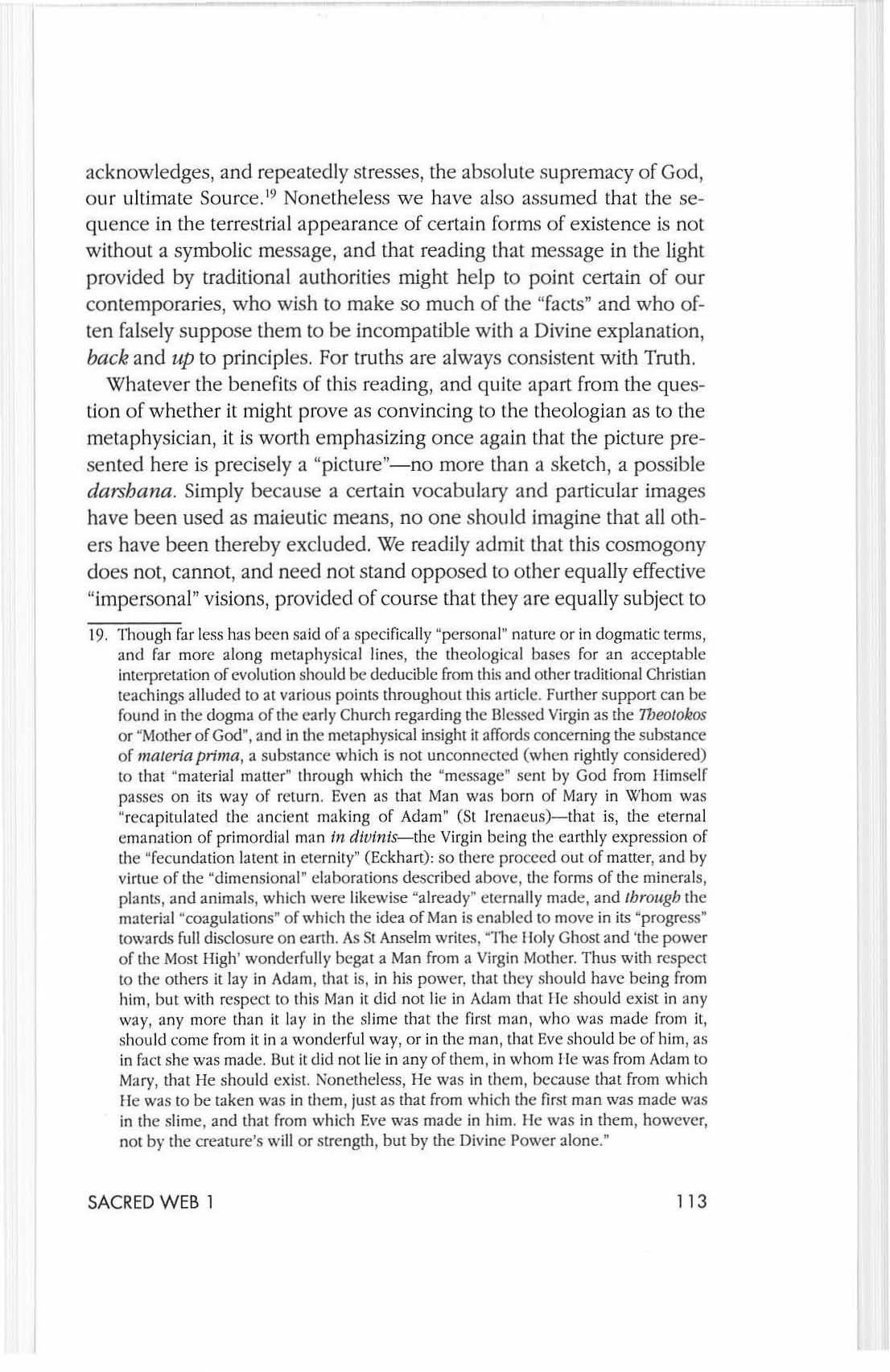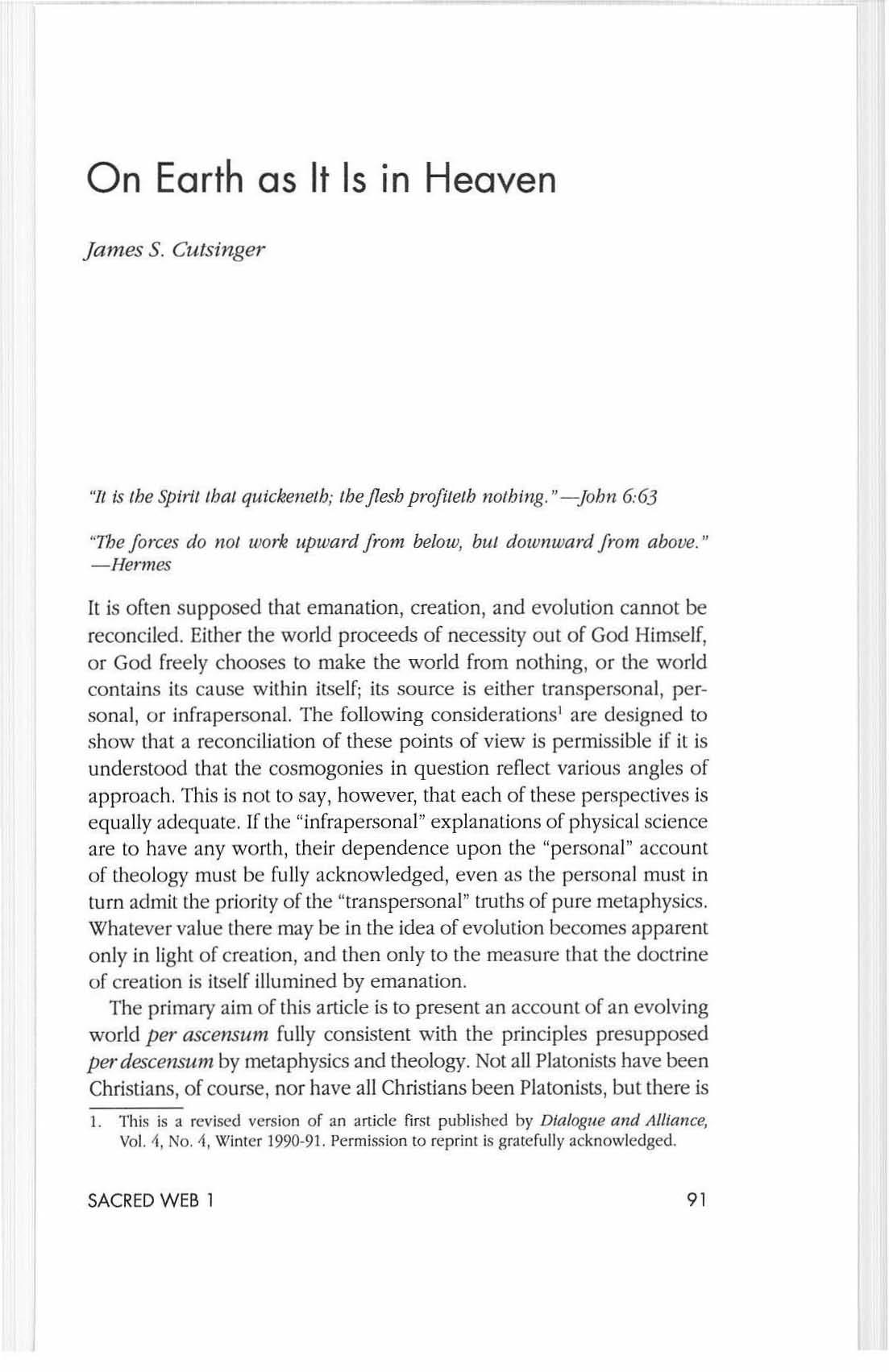
60 minute read
On Earth as It Is In Heaven
from Sacred Web 1
jam es S. Cutsinge r
"It is l he Spirit thai qUickeneth; lhe flesh profileth 'lOl!Jing. "-jo Jm 6:63
Advertisement
';71Je forces do n ol work upward from below, bUI downward from above."
- Hermes
It is often s upp ose d that e manation , c reation , and evol ut ion ca nn o t be reconciled. Eith er th e world proceeds of necessity out of God Himsel f, o r God free ly c hooses to make the world from no thi ng , o r th e world contains its c au se w ithin itse lf; its source is e ith er t ran s p e rso nal , p e rsona l, o r infrapersonal. Th e following considerations ! are d es ign e d to show th at a reconcil iation o f these p oints of view is permi ssib le if it is underst oo d th a t th e cosmogonies in question reflec t va ri o us ang les of approa c h. T hi s is no t to sa y, however, that ea c h o f th ese pers p ective s is equally a d eq uate. If the "infraperso nal " explanation s o f physical sci e nce are to h ave any worth, th e ir dependence upon th e "p e rso na l" acco unt of th eo logy mu s t be fully acknowledged, even a s th e p e rso n a l must in turn a dmit th e prio rity o f the "tran s perso na l" truths of pure metap hys ics. What eve r va lu e th ere may be in the id ea o f evo lu ti o n beco mes apparent only in li g ht o f c reation , a nd th e n only to th e mea sure th a t th e doc trin e of c realio n is itself illum ined b y ema nation.
T he primary aim o f thi s art icle is to present an account of a n evo lving wo rld p er asce nsum full y cons iste nt with th e prin Cip les pres uppo sed perdesce nsum by meta ph ys ics a nd the o logy. Not all Pla to ni slS have bee n Ch ristians , of co urse, no r h ave all Chri stia ns been Platoni slS, but th e re is such a thing as Christian Platonism This shou ld be sufficient to s how thal doctrinal positions whkh include creation within th e perspective of emanation, whether widely persuas ive or not , are a lready a maHer of record, and that it is therefore not illegitimate to speak of the metaphysician and theologian as sha rin g ce rtain common "principles." The quesli on remains, however, whether these princip les might serve to inform an evolutionary understanding of the physica l world. In its tran s fonnist o r Darwinian versions, the theory of biological evolution ha s be e n for good reason thoroughly rejected , not only by orthodox theologians , but more importantly by those among ou r con temporaries who have most forc efully propounded an integral metaphysics , and who have done the mos t to promote in th a t light an esoteric interpre ta ti o n o f the doctrine of creat io n ex nibi/o. 2 It is therefor e essentia l that the reasons for this rej ecti o n be carefully consi dered before presenting a truly prin c ip ia l th eory of evolu tion , one which is fully consistent with t he "degrees of Reality " and which acknowledges the prerogatives of a scienlia sacra. We aim in thi s way to avoid the absu rdities which usually accompany mode rn sc ientific cosmogon ies while a t th e sa me lime "sav in g the appeamnces" in th e sequence of certain natural forms.
1. This is a revi sed vers ion o f an article first publi shed by DIalogue and Allimlce, VO!'1, No.1, Winte r 1990-91. Pe rmission to reprint is gratefully acknowledged.
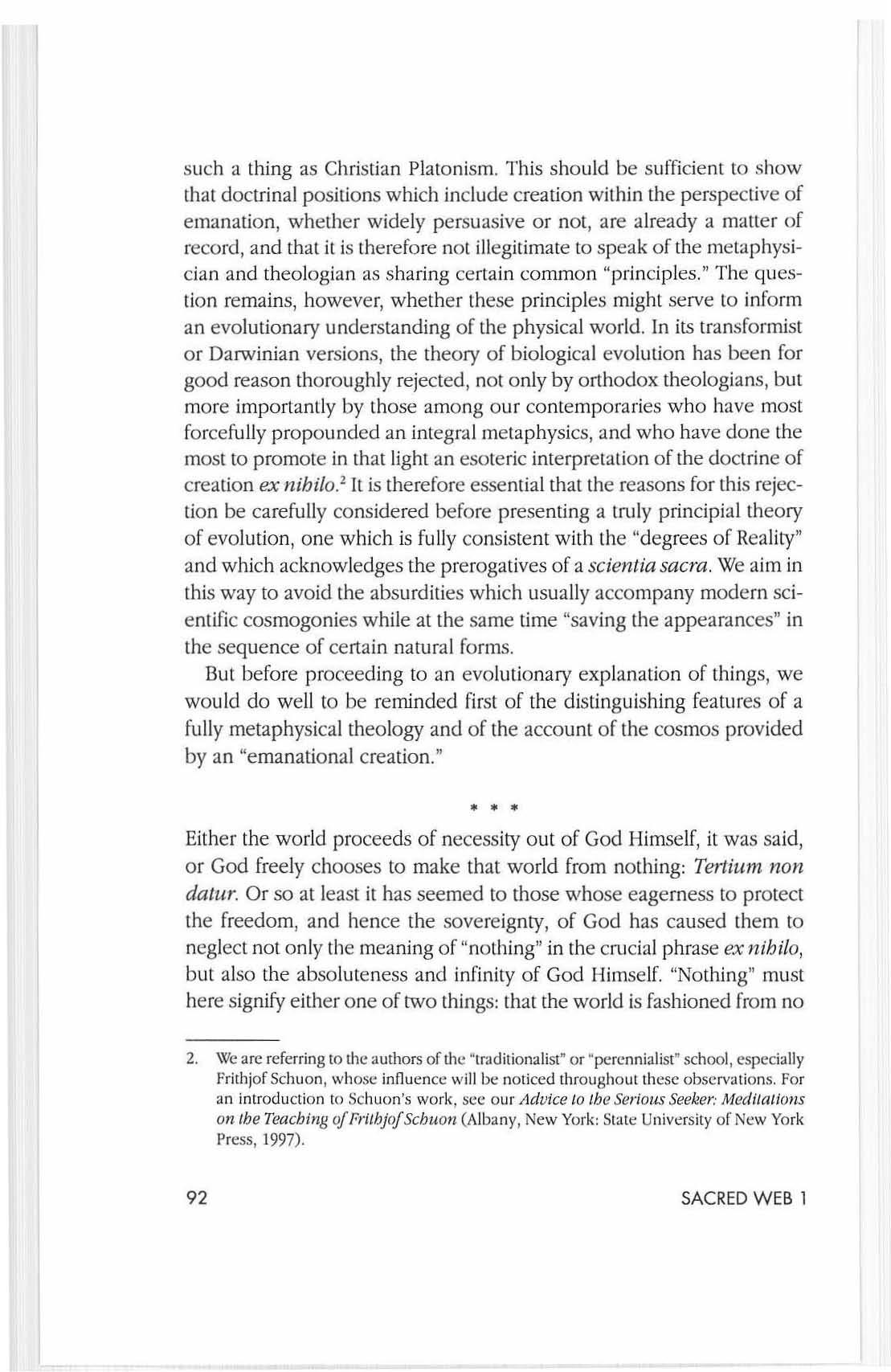
But before pro ceeding to an evolu tionary explana tion of thing s, we would do well to be reminded first of the distinguishing feature s of a fully metaphysical theology and of the account of the cosmos provided by an "emanation al c reation. "
•••
Either the world proceeds of ne cess ity o ut of Go d Himse lf, it was said , or God freely chooses to mak e that world from nothing: Tel1ium non datur. Or so at lea st it has seemed to those w hose eage rness [Q protect th e freedom, and hence the sovereignty, of God has caused them to neg lect no! on ly the meaning of "n o thing " in th e c nJ c ia l phrase ex nihilo, but a lso the absoluteness and infinit y of God Himself. "Nothing" mllst here s ignify either one of two things: that the world is fashioned from no
2. We arc referring to the authors aflhe or "pcrcnnialisl " school, especi ally Fritl1jof Schuon, whose influence will be noticed thr o ugh o ut Ihese observations. For an introduction to Sc h uo n 's work , sec our Advice 10 th e Se rious Seeker: /II e(/ ilalivlls on the Teachin g oj Frllbjo/Schlto1l (A lb any, New York: State Univl:r sity o f New York Press , 1997) .
"thing"I from no already determinate entity or entities, and of course it is not , for to speak of a cosmos is to s peak of limHation, and the or igin of limit ed "thing s" must of ne cessity be unlimited j or that th e world is made ex nibilo prae ter Deum, from nothing other than God, for the Sou rce of the being by which ex ist ing thing s are is quite evidently nOI an abso lute vacuum, nor is s uch a conception even possibl e: Ex nihilo nihil/it. But if when one says that the world is created from nothing, it is according ly meant that the source of the world is supraformal and Divine, then th e expression is clearly not a negation , but s impl y th e transposi ti on into theological terms, of e manation. The conception of "nothing " is far from a luxury , of cou rse It serves to remind us o f th e impotence and cont ingency of crea tures, of their di stance from the God whence th ey come, and of the "p resence of absence" in their make-up; and it can provide in thi s way a useful cor rect ive for metaphysical expositions in which the di sco ntinu ous character of emanation ha s not been sufficiently st ressed, and which therefore ri sk th e error of pantheism. But this e rror is by no mean s an in evitable feature of every tran spersona l cos mog ony.
Nor apart from the transpersonal and metaphysical is the persona l or c reation is t perspec ti ve free from certain ri sks of its own, for it tends not to consider with due care th e implications, and even more so the Iimils, of the Divine Qualities or Names, of which freedom is on ly one. Theologians who mistrust metaphysicians for fear that the necess ity of manifestation, unlike th e gift of creation, will compromise th e absoluteness of God, and thu s His freedom from determination, seem not to have re cognized that absoluteness imposes its own limits, not extrinsic to b e s ure , but intrinsi c and p roceeding from the essence of the Div in e Rea lity Itse lf. To ca ll God omnipotent is not to say that He can do anything, le st th e goodness of sovereig nty be marred by a purely arbitrary deployment. It is to say instead that He cannot be constrained "from th e outside in." But God may, and indeed must, be constrained by His essence, which He cannot negate, any more than a man can lift himself off the ground. Obviously God ca nnot lie, because He is the truth, and to lie wou ld be to undo the truth of His Wond-that Word which He not only speaks, but which, "being of o ne subs tan ce with the Father", He himself is. Though perhaps somew hat less obvious, it is equa ll y ce rtain that God cannot but manifest Him se lf, whether we call the result of this Sel f-express ion an emanation or a c realion. Again the necessity flows from the essence.

If abso lu te, God is "loosened " or free d from a ll limits ; He is unbound e d and infinite . But having no bounds, noth in g b ei ng able to co nt ain or enclose Him, God can not but pass "o utside " of Himself and into th e nothing, from whic h , as it w ere by d isplacement, He makes Hi s creatures come into b e in g. "None is good but God ", a n d it is the ve lY nature of the on ly Good to "commun icate itse lf' (St Augustine).
Alth ough we are using a "persona l" language in order to s how that the e manational perspec tive need no t be op posed to th eological cons iderations of God and "His U Essence or " His n c reatures, it s h o uld be clear that if th e th eo logia n took Div ine Sove re ign ty wit h complete seriousness, as he claims to be doing in rejectin g t he id ea of cosmic necess it y, he would be obliged to admit th e p rio rity of th e tra nspe rso na l, and hence th e legitimacy (to say the least) of metaphysi cs. For a Reality tru ly sove re ign and tru ly free is nOl precisely a being a t all, let al one a perso n , for these, like all ca tegor ie s, mll st impose th e ir ow n determina ti ons. Freedom a nd necess ity are thus seen to be one, and their ap parent o p position may be resolved. The world is able to proce ed of necessity from out of the Divine so as to se lVe as a manifestation o f it s Sou rce preci se ly because God is free from all th e const raints that migh t otherwise co nditi o n Hi s nature and interfere wi th H is being tru e to Him sel f, or wil h His wi s h to ex press Himse lf through hi s Word. The in ev itab ili ty of th e wo rld is in t h is se n se inte nd ed.'
A few remarks sho u ld perhaps be ad de d co nce rning the "te nse" o f emanation and c rea tion. T h e th eo log ica l account o f the origination of thing s is for vario us reasons less like ly th a n th e metaphysical to a dmit that God is "a lwa ys" making th e wo rld , even th o ugh the e terna li ty of c rea tu res in divinis is nece ssar il y imp li e d by thei r inevitabilit y, just as th e ir inevitabil ity is by Di v ine powe r, fo r "it is a li ke im p ious and a b s urd to su ppose that there was a time whe n Goodne ss d id no t do good and o mnipotenc e did not e xercise Its powe r" (O rig e n). The theologian ofte n objeclS, no t in thi s case that God has suffered demoti on, be in g constrained to act in a way He would otheIW ise not , but that th e creatio n has benefi ted from an unju stifi ed, and bl as phemous, pro motion , be ing accounted "as old as" God. But thi s is to neglect the fact that not all on to logica l dependence ex hibit s itself in chronologic al success ion, as th e filiation and process ion of th e second two Pe rson s of the Holy Tr inity sho uld be e n o ugh to esta bli s h Whenever there is a mind th ere is thought, and when ever a sun th ere is li ght , and yet the relati ons hip remains in both in stances ca usa l and asymmetr ical. And so, despite its ete rn ality, "t he universe was crea ted by God, and there is no substance which ha s not re ce ived its ex istence from Him " (Origen). What ever their di sp utes as to whether th e world ha s "a lways " existed, the metaphysician and theologian are ag reed that "as long as" there has bee n a cosmos, God ha s "always" been responsible for it. The universe is neve r a/ail accompli. I t is in each instant , or bett er betwee n every insta nt , being brought forthby Go d , the theo log ian w ill say,fro m God , in metaphysical te rm s; or as above , and accord ing to a ce rt ain fu sio n of perspectives , by God/rom no thing o th er than God. Th e perso nal and trans pe rso nal exp lanatio ns a re thus al ik e in insisting th a t the co ntin ge n cy of a ll th at is other than the Supreme Reality is such that th e cosmos cannot stand on its own, howeve r briefly , but requ ires , in order to be , th e co nt inuous infusion of un crea ted powe r Whether one think s of the world as an ema nati on or a crea ti on, th e tense of th e process is pre se nt: it is streamin g forth; it is being made.
3. "1111S synops iS is meant to refle ct a perspective much mOfe tho rough ly developed by Sc h uon in "Dialogue Between Hellenists and Chris tians n , Ligh/ 011 theAl/de"t Worlds , trans. Lord Northbourne ( Bloomi ngton, Indiana: World Wisd o m Books, 198-1); "Creatio n as a Div ine Quality", Survey alld Esole riSIII (Bloomington, Indiana: World Wisdom Books, 1986); "Ex Nihilo, III 71Je Play of Masks ( Bl oo mingt on, Indiana: World Wisdom Books, 1992); and "Theological and Metaphysical Ambiguity of the Word £:t:", 1be Eye oj the IleCll1 : Metaphysi cs, Cos mology. Spiritual Life (Bloomington , Indiana: World Wisdom Books , 1997).

• ••
Th e world as a whole, an orde red whole , and not success iv ely or piece b y p iece , is a contin u o u s production of God or (one might say) eduction/rom God , acco rding to one's angle of vision-with the "process " in eith er case being a move ment "from above to be low. " Altogether differen t o f course is the exp lanati on of the world provided by the transformist or Darwinian acco unt of evoluti on, which rests upon a total negation of Go d , th e t ru e So urc e of all c reatures, and which purp orts to accou nt for th e variety o f natu ra l forms by means of stri ctl y natura l processes, "upward from below ." Six reasons for rejecting the theory may be a ddu ced.
If th ese reasons a re only briefly considered here, it is because the c hi ef p oin t of thi s article is no t to exam ine in full all the many p rob le ms with th e transformisl theory , but to present a very d iffe rent view of evo lution, o n e w h ich takes these cri ti cisms se ri ous ly, w hich builds up on lh e m, and w hich conforms to the metaphysic a l p e rspec tive the y in part reflect.

In th e firs t p lace, th e exp lanation of order by "natural se lec tion ", as even its mo re honest proponents adm it , is no mo re than a th eory , and one moreov e r whic h can ne ve r be tes ted, let alone pro ve d. 4 Lik e a ll scie ntific theories , it is inevitab ly te ntativ e and probabili sti c, bei ng no t even so solid or certa in as the e mpiri cal data it is mea nt to ex plain , th emselves of course always subje ct, if not to doubt or deni al, th e n to co ntinual re inte rp re tation. Ha vi ng th e re for e on ly provisional fo rce, because an o ri gin s trictly induc ti ve, t he Darwini an doctrine s im p ly ca nn ot co mp ete at th e sa me level of truth w ith e ithe r metaphysics o r th eo logy. Of these, th e fo rm e r p rocee d s from noesis or in te ll ect ion , wh ic h involves the direc t apprehens io n of the Real as Objec t by virtu e of th e Rea l as Su bject ; it is a matter of lheoria , not theory , an d rests upon the knowle dge of lik e by like , when What truly is so b ecomes aware of Itse lf. The latter, th eo logy, th oug h nOl eq u a ll y ce rtai n w ith re s pe c t to its mode o f reception, is equall y true in its co nt en t; for theolog ica l thinking-o n e mus t add, in its o rthodo x form s- is dependent on Rev e lati o n, and Revelation is inte ll ec tion quenched as it were in the form of re s ult: no t know ledge , as Plato wou ld say, but tru e o p ini o n , ort h odoxy. Op ini o n pe r se, however-w hatever so -and-so happens to think at thi s mo ment abo ut his more or less regular con tacts wit h th e more or less fluid d o main of so-called phys ical "thi ngs "- is co mparable to neither ; and a th o ugh t depend e nt on th e dat a o f se n se cann o t but be an opinion.
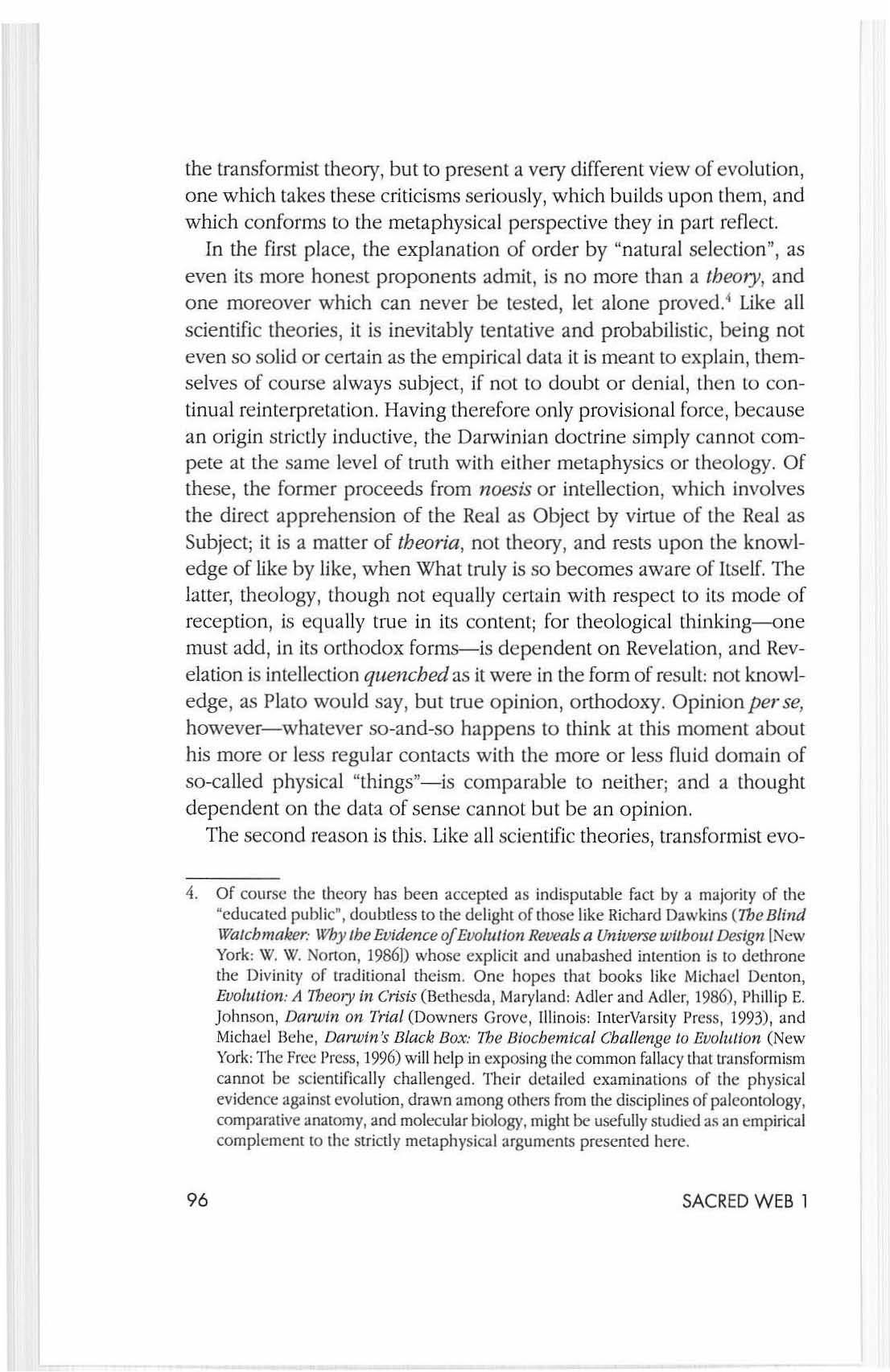
The second reason is this. Lik e all scie ntifi c theories, lransformis l evo-
4. Of cou rse the th eory has been accept(.-d as indi sputable facl by a majority o f tile cducated d o ubtle ss to the de li ght of those like Richa rd Dawk ins (7be Blind Watcbmaker: Wby Jbe Evidenceo!Evo!ulfon Reveals a Un i verse w ilb oul Design INe w York: W. W. Nono n , 1986]) whose exp licit and u na bashed intent ion is to deth ronc the Di vinity of tr ad iti ona l th eism. One hopes that boo ks like Michael De nt on, EVO/uli o ll : A 7beOly in Crisis (Be the sda, Mary land: Adler and Adl er, 1986), Phillip E. Johns o n, Omwlll on Trial (Dow ners Gro ve, Illinoi s: InterVars it y Press, 1993), and Michael Be ll e, Darwin's nlack Box: tbe Biochem i ca l Challenge lu Evo llllf ofl (Ne w Yo rk : Th e Free Press, 1996) will help in exposi ng the common fallacy that trJnsfonn ism cannot be sc ie ntifi ca lly challenged. Thei r d e tail ed examina ti ons of the physical evidence agains t evo luti o n , drawn among others from me di Sciplin es of paleonto lo gy, com p arative an atomy , and molecu lar bio logy , migh t be use fully stud ied as an empirica l comple ment to the strictl y m e tap h ysica l argumenLS pr ese nted here luti on (even supposi ng its validity) is limited to th e strictly material or terrestrial plane, wh ich is only a pan of the cosmos, the least real and acco rdingl y th e least intelligible. As he attempts to explain what he sees, the Darwinian theorist neglects to rem embe r that what can be physically sensed is not only much less than the whole , but less real than the "parts " of the whole which it is n ot, as the images of a dream are less real than the objects of waking perception. And yet this quite partial character of his hypothesi&-and by "partial" I mean both "biased" and "inco mpl ete"- is se ldom if ever cons idered. Ju st th e reverse: it is often as· sumed instead, not that a ll that is said about fossils applies in addition all the way up to the angels, though this would b e more absurd enough, but that th ere is no "up" in the fir st place, nothing besides matter at all. De non apparentibus et non existentibus eadem est ratio. The indefen· sibl e presumption of this materialism should be obvious.
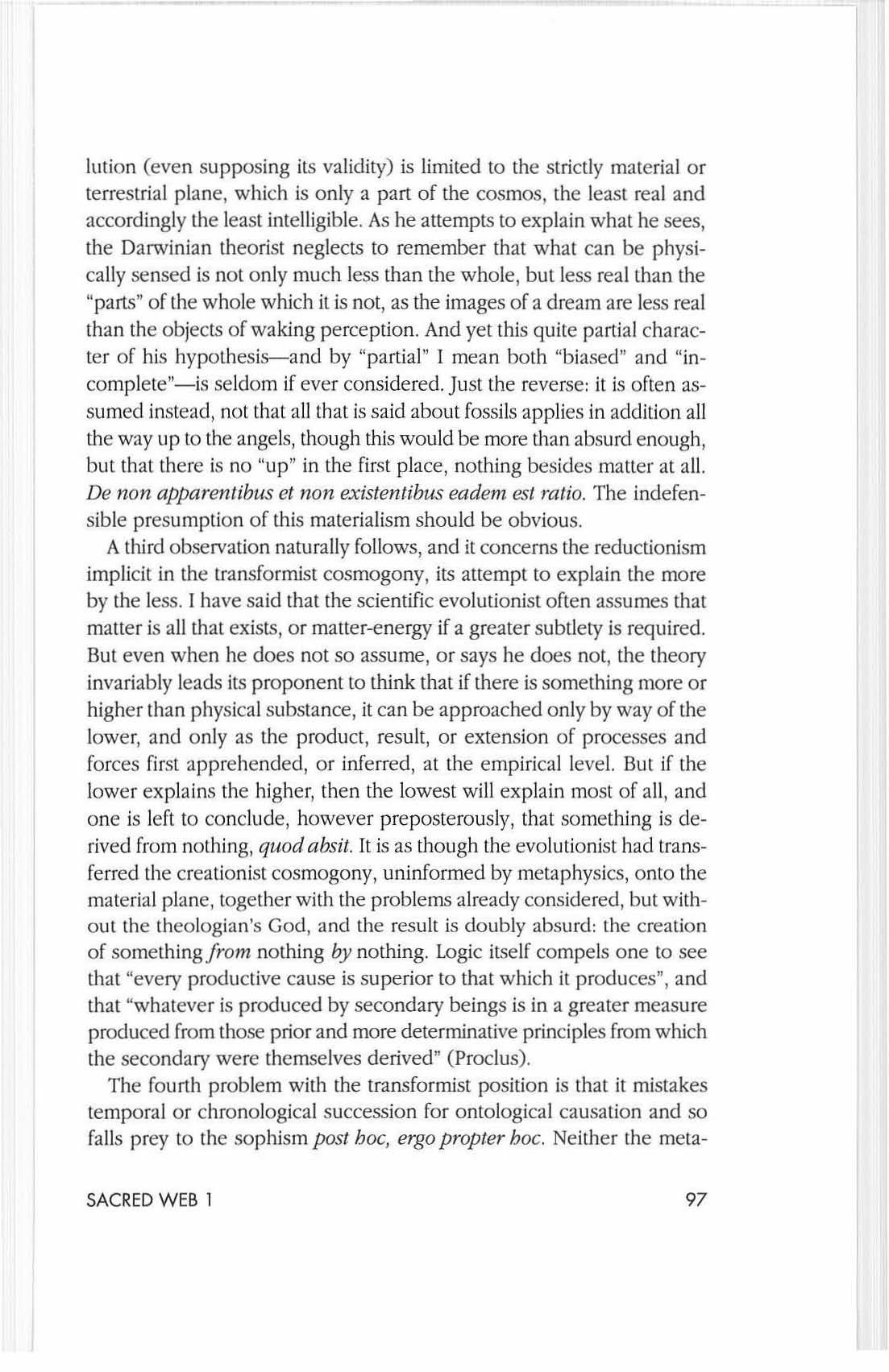
A third observatio n naturally follows , and it concerns the reductionism implicit in the transformist cosmogony, its attempt to exp lain the more by th e less. I have said that th e scie ntifi c evolutionist often assumes that matter is all that ex ists, or mauer-energy if a greater sub tl ety is requ ired. But even when he does not so assume, or says he does not , the th eory invariably leads its proponent to think that if th ere is somet hing more o r higher th an physical substa nce, it can be approached on ly by way of the lower, and only as th e product, result, or extension of processes and forces first apprehended, or inferred, at the empirical level. But if th e lower explains the hi g her, th en the lowest will explain most of all, and one is left to concl ude , however preposterously , t hat something is derived from nothing, quod absit. It is as though the evolutionist h ad transferred the crea ti oni st cosmogo ny , uninformed by metaphysics, onto th e material plane, together with the problems already conSidere d, but without the th eolog ian's God, and th e resu lt is doubly absurd: the creation of somet hing /rom nothing by nothing. Logic itself compels one to see tl1at "eve ry productive cause is supe rior to that which it produces \ and that Uwhatever is produced by secondary beings is in a grea ter measure produced from tho se prior and more determin ative principles from whic h the secondary were themselves derived" (P roclus).
The fourth problem with the transformist pOSition is that it mistakes temporal or chron ological success ion for ontologica l causatio n and so falls prey to the soph ism post hoc, ergo propter hoc. Ne ith er the meta - physician nor th e theologian denies , or needs to deny , that th e fos s ilized vestiges of various species of organic life appear in the geological record in an order of increasing comp lex ity . Nor must he potiit some ex tr aordinary act of God by virtue of which that record was made to appear as it does by a miraculous "pre- fabrication ", after the fas hi o n of certain "scientific creation ist n sc hemes. In stead he accepLS the fact, though a priori and not by indu c tion , th at the va riou s kinds of plants and animals have appeared s u ccessively over time , with th e sensib le manifestation of humanity com ing near th e end of the process. But appearance is one thing, and Rea li ty quite another. To admit that reptiles roamed th e earth before th e appearance of mammals , or more prec isely that they entered into th e substance of physical bodies in advance of the mamma ls, does not entail the admission that the lauer, by whatever temporal and biological channels one might wish to propose , therefore cameJrom the former, though they may in a se nse have come through th e m , as I shaH lat er suggest. TI,e metaphysician teaches instead, and quite the reverse, that th e order in which the various s pecies have b ee n dep loyed over time, and thu s the evolutionary seq ue nce of their disclosure in malter as physica l organ isms, is just the oppos ite of their "origina l" o rd er as archetypes or Divine ideas. Inasmuch as the world is th e reflection of God , and in asmuc h as reflections invert , thi s is precise ly w hat one shou ld expect-a kind of chiastic redupli catio n of th e higher in th e lower. It is essential of cou rse to remember that the procession of the world out of God is eternal, hence in temporal terms both continuous and instantaneous. When it is sa id that rnan 's appearance on ea rth toward the end of the cosmological "process" is the invert ed reflection of hi s th eo logical and rnetaphysical primacy in the Divine Logos, it should be understood that thi s prima cy refers to the "s patial " supe r-ordination of human beings over animals in a purely ontological , s tatic , and vertical se nse, and not to their being an init ial effect in a ser ie s of seq uenti al c reational acts. Man's primacy is that of the microcosm , of a "container" with respect to its "con tents."
Fifthly, the Darwinian conception of evo lution is utterly blind to the essential d istinc tion of form from s hape By the word "s peci es" it means to signify what many individual organ isms hav e in comrnon: a notional abst raction derived by generalization from part icular facts and serv ing as a linguistic 1001 for classification. But th ese facts are all of an emp iri - cal, material kind and have to do solely with stru ctura l resemblances and other physical fea tures susce ptible to measurement and quantification. A species thu s considered , ab extra ad intra and as it were by dissec tion , is therefore dependent on shape , even as shape is a function of surfa ce. Dy "s urfa ce" we do not mean only the most outwardly ex ternal p lane of a n organism 's solidity, the place where its skin (or so me similar feature) meets th e air, but also whatever relative ly inw ard part of its physica l substa nc e co uld be exposed to the air, in fact o r in principle, if our techniques were su fficiently refined. In this se nse, what can be see n even th rough the most powerful of elec tron microsco pes, or read on the sc re en of some other highly soph isticated dete ct ion apparatus, is still only "surface", and still therefore a matter of shap e. Form is quite different. 13y "form" th e metaphysic ian means to refer to th at quality by virtue of which a physical object, whether li ving or not , tr ansfers the attention o f tho se who perce ive it through itself and along a kind of ontological corridor up and into its ce lestial archetype. Form is liquid where shape is so lid , though so lids of course nonethe less display th e various forms; form is tran sparent or diaphanous whereas shape is opaque ; fo rm insists that it not be confused with a surface. As shape is the pla ce where empirical apprehension must necessarily SlO p on its way in th e direction of being, form is the place where being willingly pau ses on its way in the direction of knowledge. Form is on the "other side" of th e existence of things from species and sha pe. Not at all derived from those thing s or dependent upon them, they are rather derived from it. It is w hat accounts for th e qualitative existence of the anima ls or plants that possess it in conunon-whose commona lity or similarity, however, far from being the measure or the standard of form, is as mu ch an indi cation of the fragmentation and incompleteness of th ese particular creatures as it is a reminder of that which is whole, and which th ey seek to emu late, wh ich is, once again, their form . A truly adequate cosmologica l explana ti on of the world is an ex pl anation of forms and their hi erarch ical o rd er, and of That which they wish to express. But all this , fo r obviolls reasons , is quite beyond the expectations of a strictly empirical scien tifi c method , the kind of method that has generated th e transformisl doctrine.

Th e sixth and final problem with this theory, th e most fatal of all, is its failure t.o account for the mind of the theorist himself, and thus its sui - cidal self-contradic tion. If the Darwinian is correct that the body of man, his brain included, like the bodies of the o th er animals, is the resu lt of the operation of certain subordinate forces, whether physical, chemical , or biological; and if he is correct to assume that the mind is in some way a function of organic tissue and that thoughts are the result of electrica l transmissions in the ce rebrum: then prec isely because of hi s claims he is not correc t, nor could he b e "co rrect" whatever he said. For from thi s point of v iew, no idea, including the theory o f evolution , is true; none is conformed or adequate to the actual nature of thing s in a way that its competi tors are not. If the transformist is right, all idea s, including his own, and thus a ll possible theories, are already equally co nfo rm ed to the real , because t he y are all equa lly determined to be what they are by their respective biochemical histories. And so to repeat, ifhe is right he is nOlo Truth , like the mind which thinks it , requires a freedom from all conditioning , hence a freed om from all "honzontality ", all physical process, and thus from the whole of nature, which is by definition a concatenation of effected causes and caused effects. Nothing is lrueincluding the stat eme nt that "nothing is tnJ e"-uruess the power of knowing within us "came down from H eaven", having proc eeded out of the only completely unconditioned Reality: the Source of emanation and the God of c reation. "In Him was life, and the life was the li ght of men. "

In sum, the Darwinian theory of evol ution refl ects in various ways , and as considered in its seve r al particulars, each of th e more or less typical tendencies of modern critica l thinking: it is by turns empiricistic , materiali stic , reductionistic, historici stic, nominalistic, and relativistic. It is a veritab le "hydra of heresies. " And it is for this reason that th e th eory has been the object of so severe a reproach on the part of both th e metaph ysician and the orth odox th eolog ian. Let us be clear. The evolutionism which mu st be repudiared is in no se nse the claim that th ere has been a sequence in the appearance of th e forms of life on this planet , nor that changes have occurred and continue to occur in the physical constitution of the various species of plants and animals, for these facts, to the degree that the data of sense ca n provide us with "facts", are amply attested by the geo logical record, by the techniqu es o f radiomet ric dating , and by the o b servations of breeders. s What must be rejec ted instead is the attempt to explain such changes in strictly physica l terms as if that explanation accounted not on ly for in tra-specific differences be- tween individual organisms, but for the exis te n ce and variety of species as s u c h, and as if those species had deve loped ex n;hilo from the s imple to th e comp lex, w ith the inanimate giving rise to th e animate, the mate to the sentient, and the sentient to the last of which must clearly be firs t in any intelligibl e causalionai series. Efforts to d escribe physical phenomena at th e level of empirica ll y observable ca u ses alone are one thing , and are as useful in ce rtain limited cases as they are unobjectionabl e. But it is quite another to in s ist , as the more hyperbo li c of DaIWinians often do , that an empirica l exp lanation renders all other accounts of th e same phenomena imposs ible, or that it can account in addition for the origin of non-empirica l realities, or (worst of a ll ) (hat it somehow prove s that only such things ex is t as can be empirica lly measured. Herein li e the absurdities menti o ned earlier.
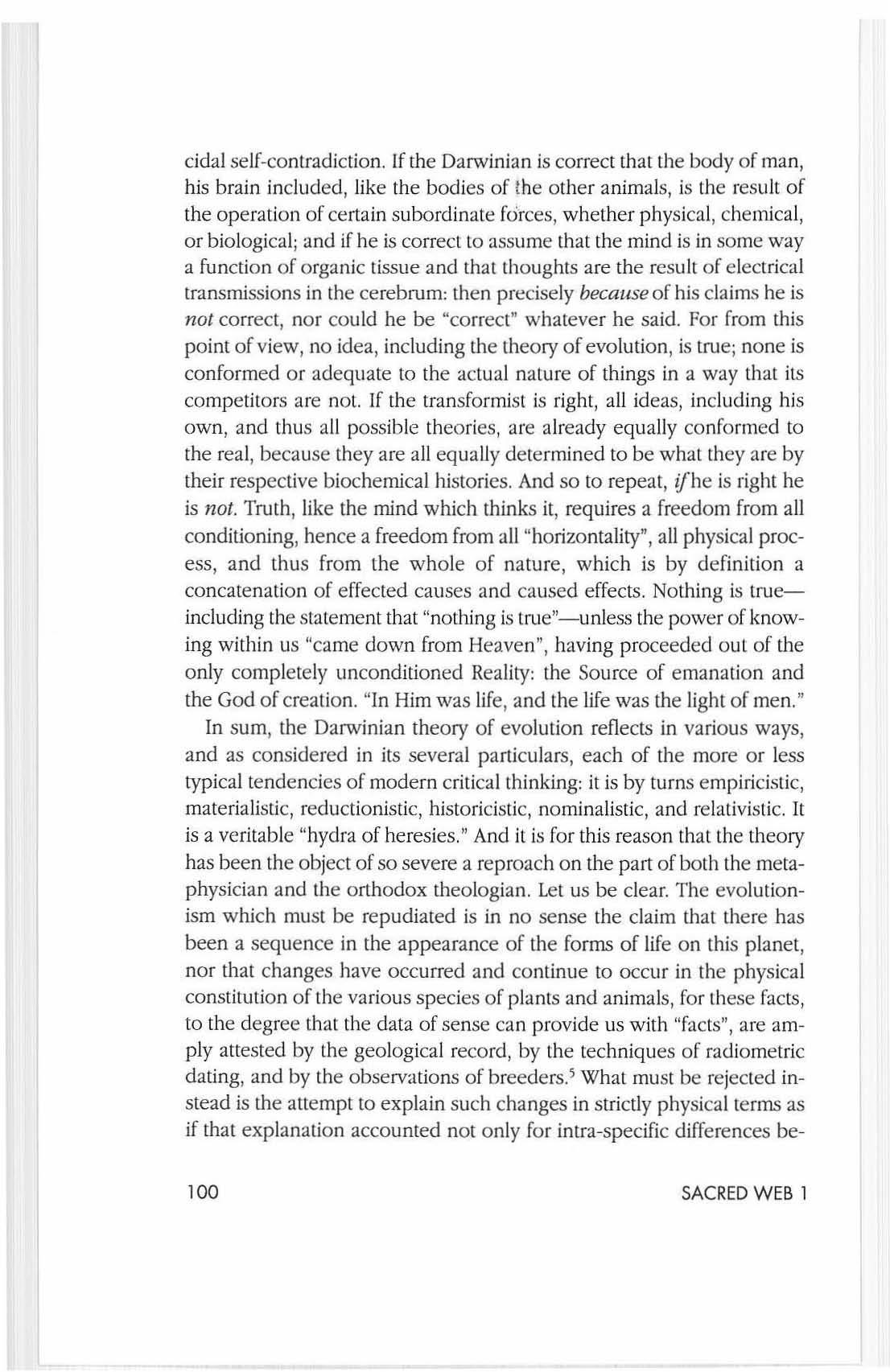
• • •
The question remains , how e ver, whether it is possible to formulate a view o f th e cosmos from an infrapersonal angle that is free from these severa l defects. Can the major forms of life in this world b e describ e d accord ing to the temporal ord e r in which their appearance occurs per ascensum, but so as to protect the metaphysical and theological truths of their "original Origin "-from and by God per descenswn' Is it possib le to envisio n th e c hron o logica l o rd er among the kingdoms on earth in s llch a way as to see, by a kind of noetic tran spos it ion, their ontological order in God'
In order for this qu estio n to be answered in th e affirmative, it is essential that one first understand the purpose o f cos mologies in generalperhaps we shou ld say of traditional cosmologies or "natural sciences", les t they be confused with fi e lds of stud y like astrophys ics, which though it may purport to cons ide r the cosmos as a w hole s uffers in obvious ways from the same limitati o ns as the o th e r empirica l sciences. The traditional intention is basically this. Whatever shape il takes , and wha teve r th e symbols or language it might employ , a true cosmology, by virtue of its conform ity with metaphy s ica l and theological principles, must be such as to make the natural a mea ns of support for our awarene ss of the supernatural, whenc e nature proceeds and upon which it is permanently and perpetually dependent. A vision of the world wh ich is not conducive to this intellection, and hence to the actualiz a tion of what is highest in man , s imply cannot be admitted as valid. The strictly utilitarian tend enc ies of our age notwithstanding , the on ly good reason for an infrapersonal approach to th e cosmos is that it might serve as an aid on the sp iri tual path toward the trarupersonal If it fails to do this , it has lost its very reason for being. Indeed thi s is the most fundamental d anger with Darwinian evolutionism, that it c auses a man to forg e l where he came from, thus abolishing his n obi lity .
5. "Modern sc ience is right when it describes the s ucce ss io n of geological periods, but not when it tries to descrihe the origins of life o r o f intelligence. Modem cosmo logy cannot be something other than geology, paleon tology, and astronomy; and there exists not the least difficult y in combi ning them either with Se mitic creationism or with Indo-Greek emanat io n ism , for the s imple reaso n that facts arc always co mpatibl e with (Sc h uon, unpubli s hed letter to t he autho r).
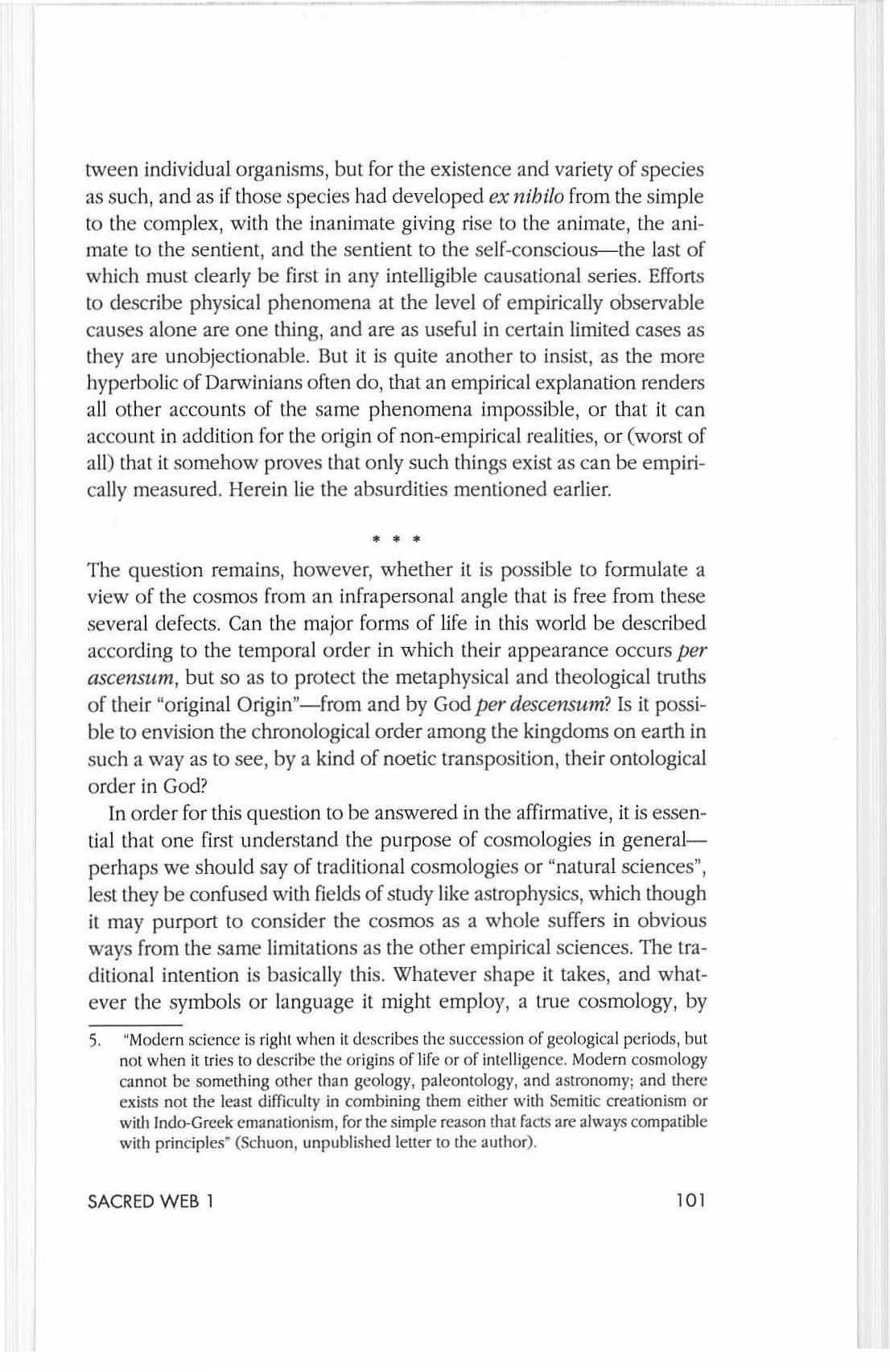
Nevertheless, provided that this danger is kept in full view , the metaphysician and theologian need not in principle be opposed to the idea that th e world is evolving. There is after all nothing etymologically wrong with the word "evolution", nor anything intrinsically ab su rd about eve!), activity or pro cess which it might b e used to signify 6 As we have see n, the transp erso nal e xplanation is agreed that the cosmos be co me s what it is through an "unwin ding " or ex pli ca tion of What is already inside, which is "turn ed out " or evolved into what It is inirially not but can then be seen in. As long as th e true nature of this original "i nw ard ne ss", which is of course God in H is immanent presence-Uthe dearest freshness deep down things "-is not debased by co nfu sio n with something crea te d or re lative; as long as we recognize that ir matter can be said to evolve, it is on ly becau se of the prese nce within it of the Supreme Rea lity, which it expresses and see ks to return to; and as long as we realize that the world is not what the materialist think s, but at once a symbol, a veil, and a channel: th en an evolutionary cosmogony can be legitimately entertained , nO[ s imply as an acce ptable thea!)' , but as a genuine IheOlia , a v is ion
6. The term obviollsly had a prc- Oanvinian hi s tory The ea rli es t English uses re corded in the Oxford English Dictiollary are by two of the Cambridge Platoni sts, Henry More and Ralph Cudworth, whose understanding of Ihe world and its creatures was quite far from tr ansforrnist. And when Dr Samuel Johnson lat e r wrote Ihal "he whose task is to reap and thr esh will not be contented without examining the evo luti on of the seed", it is clear hI: was speaking of h ow oaks come from acorns, and not men from the "lower primates ". On the other hand, these philological dat:L should not blind us to the fact that the connota ti on of the term has certainly changed sinCe thl: eighteenth century, and that its user today must be extremely cau tiou s lest he be Ihought a Darwinian opening up into me taphysical insight. If it is the case that th e cosmos is a message se nt by God from Himself to Himself, then we ma y ex p ec t the me taphy sical tr u th of emanat ion, which considers the world as proceedingJrom God, a nd the theologica l truth of creation , w h ic h ex plains the world as fashi oned by God, to be open to a co rre s p ond ing sc ie ntific "truth "! according to which the wo rl d is envisioned on its way ba ck to God; and we w ou ld not be wrong in ca ll ing thi s last process an "evoluti on."
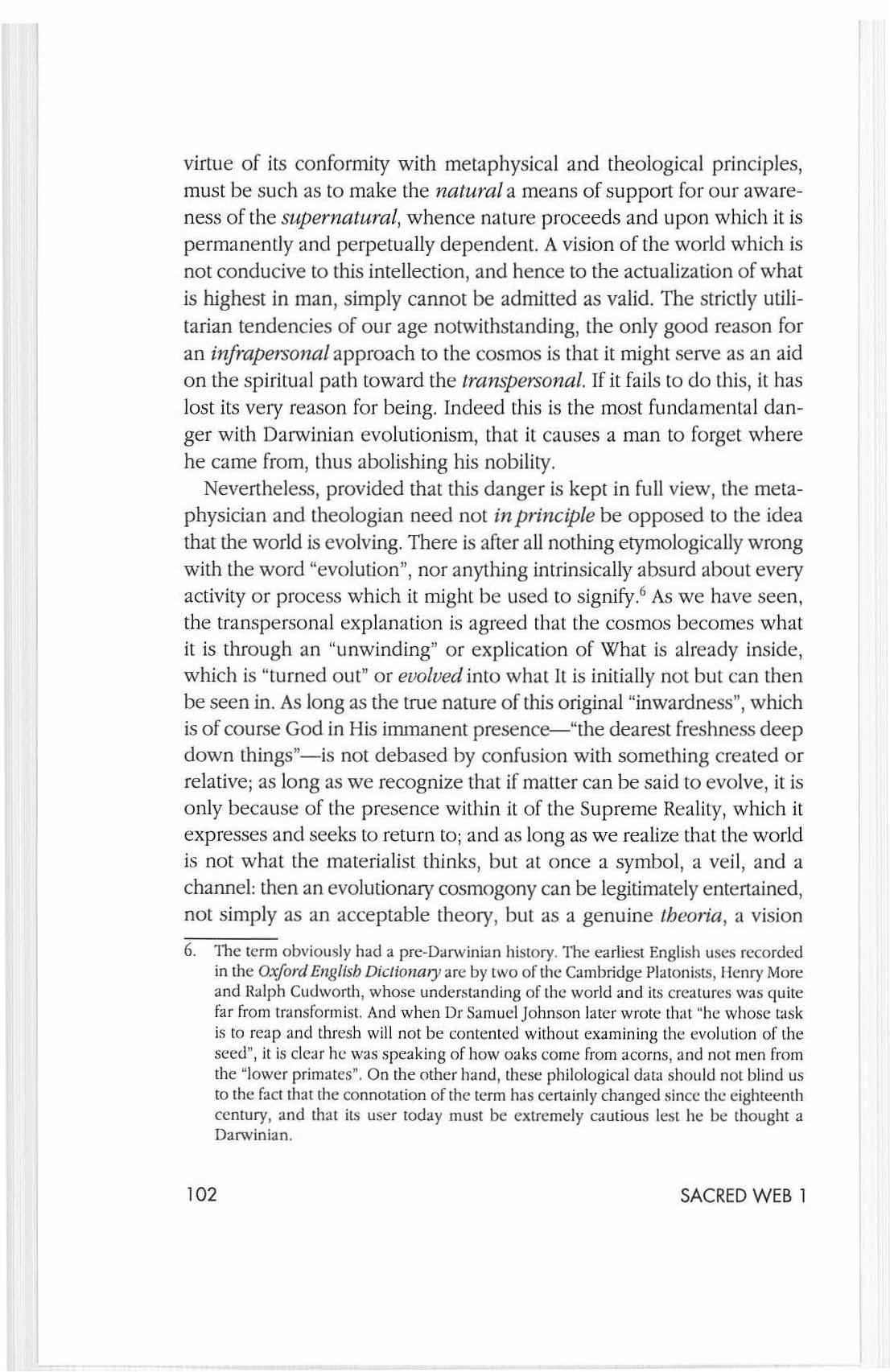
The di sti nctive feat ure s of an evolution consistent wit h God and conformed 10 H is nature h ave a lready been anticipated indirectly, a nd by cont rast, in OUf treatment above of the six Darwinian errors. The ta sk now is largely one of organization and synthesis as we present a sket ch, not of course of transformism , but of what might be called an "e manational evo lution. " The word sketch should be st re ssed. What fo llow are no more than leading thoughts , provocati ons and pictu res, designed to sugges t a possible li ne of reflection. There is ce rtainly no intention of exhausting the topic , nor do we aim to anticipate all the conceivable objections. It should be emphas i zed in any case lhallh e tempora l lerminology wi th which we are obliged to s peak is not to he taken lit era ll y , for o bvi o usly God is not Himself subject to the d eve lopme nts here envi sioned; only in seeming does the depl oyment of creat ures "tak e time ." Th e diffi culty , of course, is that our discursive thought must by defin jli on do it s work in that seenting and with the material s thus afforded. He nce "s tag e and seq uence are transferred, for clarity o f ex position, to th ings whose being and definite form are eterna l" (Plotinus).
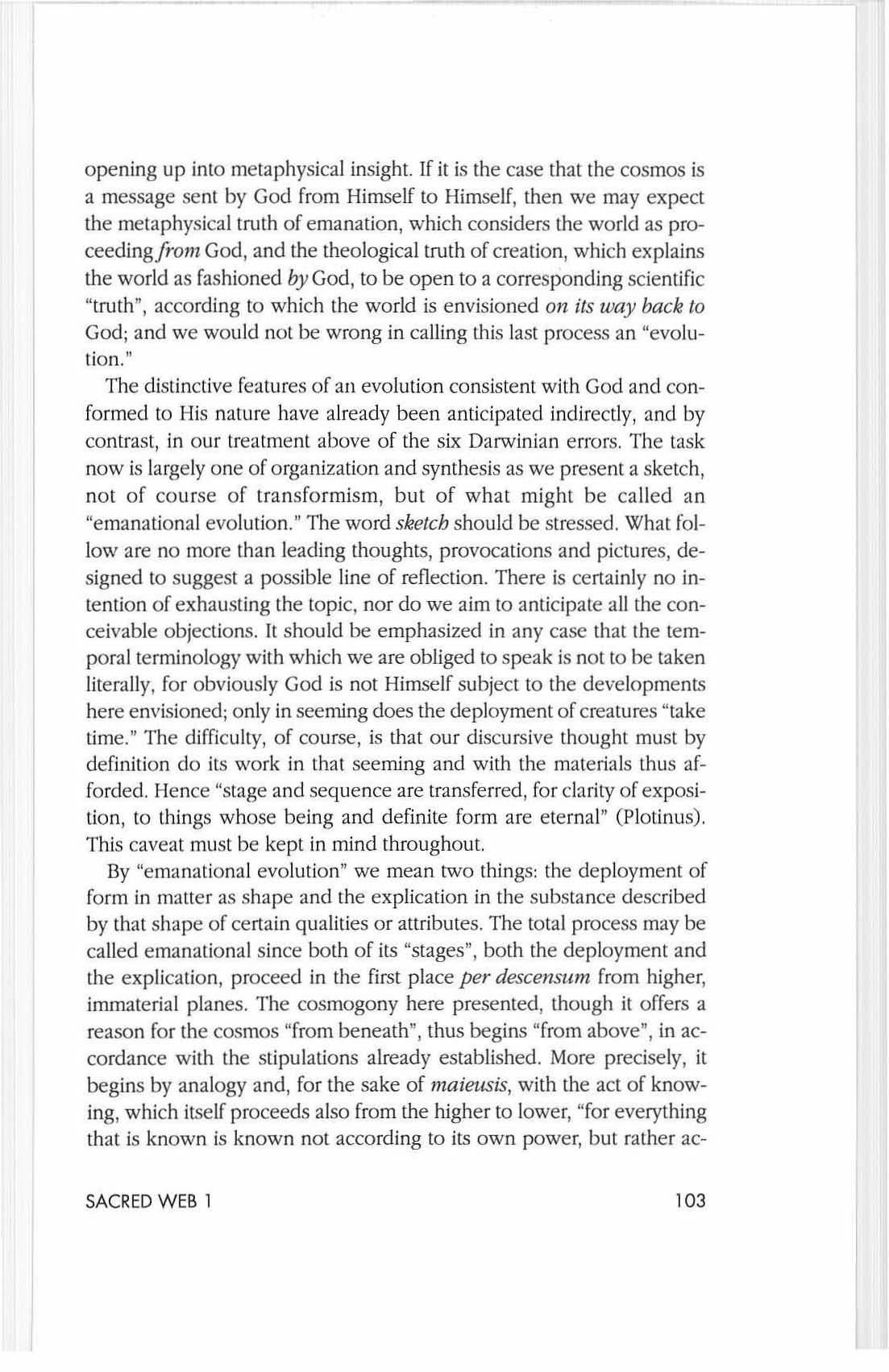
T his caveat must be kept in min d throug hout.
By "e manationa l evolution" we mean two things: the deploym en t of form in matter as shape and the explication in the substance de sc ribed by that shape of ce rta in qua li ties or attributes. The total process may be ca ll ed emanat ional since both of its "s tages ", both th e deployment and the exp lication , proceed in th e fi rst place per descensum from hi ghe r, immateria l pl anes. Th e cosmogony here presented , though it o ffers a reason for the cos mos "from be neath ", thu s begins "from above ", in accordance with the stipulati ons alread y es tabli shed . More precisely, it begin s by anal ogy and, for the sake of ",aieusis , with the act of knowing , whi c h itself proceeds also from the higher to lowe r, "for everyt h ing that is kn ow n is known not accord ing to i ts own powe r, but rather ac- cording to th e capac it y of the kn ower" ( Boethiu s). And it begin s by implication with that One whi c h is th e principi a l Knower, and kn ow ing Prin c iple, whe reve r th e knowl e dg e o f being a ri ses. The metaphysical scien ti st o r cosmo log ist begins in thi s way with th e Self as Subjec l. i
Th e Se lf is tru ly Subject only in it s recogniti on of ILse lf as suc h , and only in knowing Itse lf as the Kn o w e r It is, hence o nl y to th e extent that It an object as we ll . One says "as we ll " , but of cou rse the Prin c iple from which we a re starting , and which th ese altoget her inadequate words are meant to evoke, is not an object as well a s or in addition to Subject. Rather than both It is neither, though within this "no ndu a l" tr ans p e rsona l primacy , It is n o n e th e less ra th er morc lik e w hat is meant by a subj ect than by an objecl. If we allow as a provisional mea ns th e language of c h ange a nd tran s fo rm a ti on in th e case o f the s tr ict ly c h angeless and impa ss ible , it ca n b e s aid that what was "once" purely Su bj ect "becomes" Its ow n object in th e "mid st" of Its act o f knowin g , fo r we are speaking o f so mething w h ose very nature is s uch that It ca nnot but ra dia te outside of Itself, o utside Its "initia l" subjec ti vity, thu s taking the fo rm of "whateve r is left " - lh at is, th e objec t , in w hate ve r modality one might wish to imagi ne . Of co ur se, to s p eak in these temporal te rm s is o nl y sy mboli c, as we have a lready noted. What are here being pi ct ure d as the stages o f a process in tim e are in fact the mu ltipl e s ta tes of a Single, non-temporal Essence. 8 T he s tages are no more than superimposed "transluc e ncies" of vary ing colors thro ug h w h ic h o n e is inte nd ed to glimpse , as "through a glass dark ly " , th e infinity of that Esse n ce
It may prov e h e lpful to mak e u se of an image . Co nsider a point. The geomet rical point is after all the closes t of a ll mathematical fo rm s to th e nature of th e Subject and to the roo t o f inte ll ec ti on. Altog e th e r ind ependent from objec ts, eve n fr o m th e dot th a t se rves as its representa- tion, but whic h is al rea d y more extended than an actual punctum, th e point is pure inwa rdn ess, uncompromised by any equ ivalent externality to w hich it might o Lh elw ise be th ought t o correspond. It is "a n inside witho ut because pri or to an outside. n9 And yet agai n li ke the Subjec t , the point tends to search for itself, to sp ill over the e d ges of its in visib le and dim ens ionless essence into the dimensions of the thin gs that are seen. In seek in g it se lf, it produces in the first place a lin e, a fi gure we may mistake for a co ll ec ti o n of di sco ntinuou s "points", blll w h ich (as Zeno implied) is more like an e ffort or energy su spended between them , or belter e).pended by o ne s uch point-s tretch e d as it were b e tw ee n itself in the form of s ubje ct a nd itse lf as found in th e object. This lin e, o ne mi g ht say, is th e line of kn owledge , co nne c ting th e Se lf or Prin ciple w ith eac h o f Us innumerab le ob jec tifications.
7 No attempt is hcre made to defend the Platonism and Vcdantism implied by these asse rtions, th o ugh th e s ub stance of Ihal defense is impli c il in Ollr reference above to the sixth of the Darwinian mistakes. An explicit and exte nd e d cons id eration o f t he primacy of conscio usne ss can b e found in our book 111e Form of Trans fo rmed Visio n : Coler idg e and the Kn ow le dge or God (Maco n , Ge org ia ; Mercer Univ ers it y Pr ess, 1987).
8. ''The co ncep t of multiple s tate s permits us to enviS<lge all these sta tes a s ex is ting si multaneous ly in one and the sa me being , and no t a s only able to be traversed succeSS ively in the course of a ' de scent ' which supposedly passed not on ly from one being to a nother, but eve n from one speci es to another" (He ne Guenon , ·111e Multiple States of Being , tran s. Joscelyn Godwin [Burdett , Ne w York; Larson Publicati o ns, 1981 1 , 73).
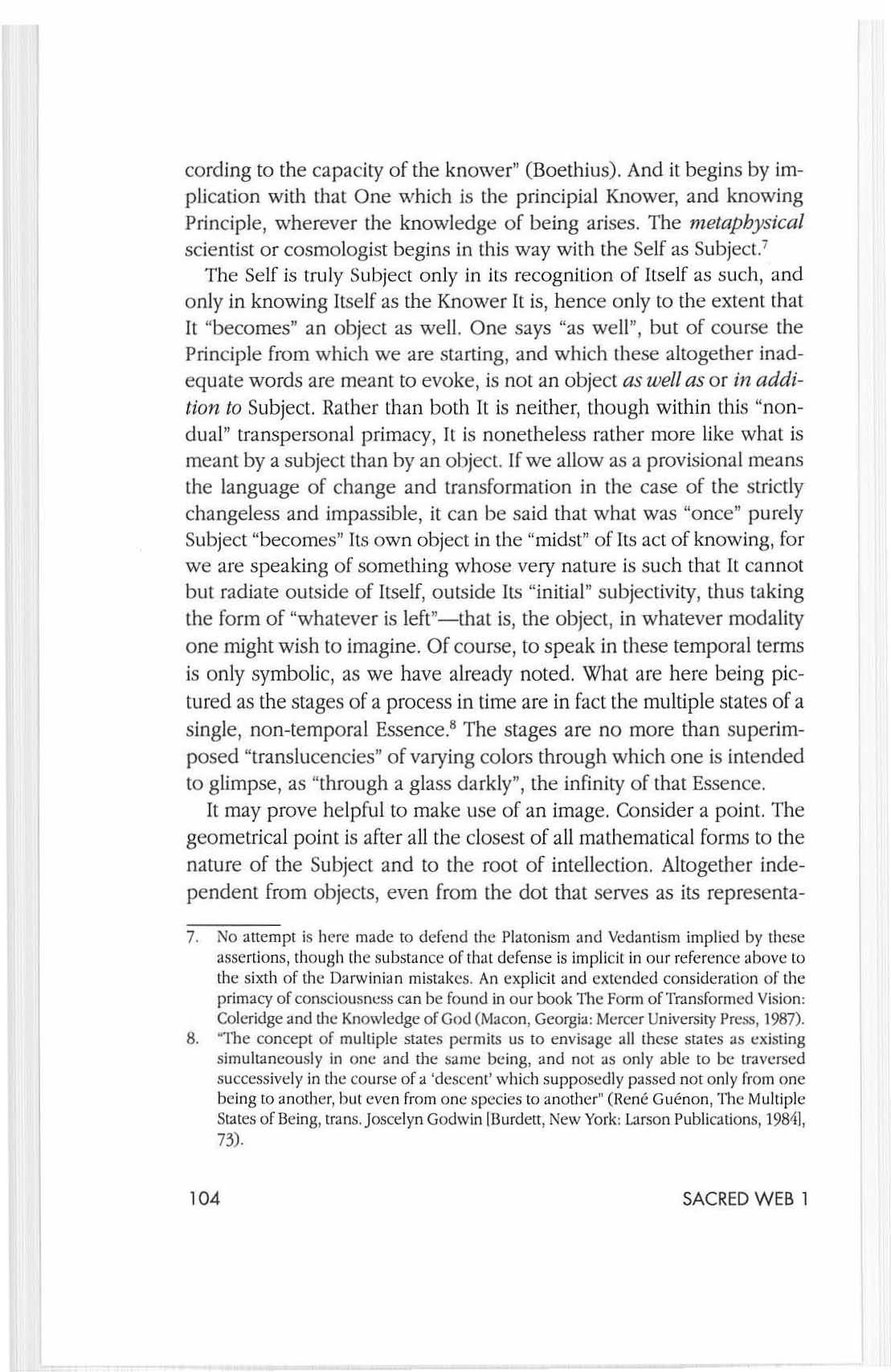
But th e point is n ot "sa tisfied " with the line, which actualizes its possibilities in but a si ngle direction. It se arches for b readth in addition to le ng th, p ro jecti ng itse lf a t right angles to its o rigi n al motion. In this way, t he plane is "evo lve d ", which in metaphysical terms is th e demarcat ion of a particular level of being-in this case, below th e Divine but above t he visib ly human-a plane whic h provides for the "clothing " o f the asye t-imm ate rial e ntiti es that dw e ll upon it. No longer quite pure in its initial inwardness, the point as exp re ssed in this dimension is nevertheless s Ull int angib le, in v isib le, and unreSi st ing-s tili fluid because having no depth o r ph ysica l s ub sta nce, containing as yet nothing external in any material se nse. Here is th e fie ld, in traditi o nal cosmo logica l language, of th e s ubtl e body a nd its w o rld , the mundus imaginalis.
And yet , s till unqu e nched in it s thirst , the Subje c t as p o int b ecome lin e and th e n plane must "exp lode " once again, in thi s case into the so lid 10 It is now for th e first time that the energy of o nto logi c al knowing becomes coag ul ated or fixed, as what was before a "g as " and th en a "liquid " now becomes "so lid ", possessed of three d ime ns ions. What ha d
9. 111is loc ution is bo rrowed from Co ler idge, as is the point as image o f the Subj ect. Sugges tion s for several ad d itional features of our C'dn be found in Coleridge , Blograpbla lIterarla, ed. James Engell and W. Jackson Bate (Princeton : PrinCC10n Univer si t)' Press, 1983) , Ch 12 ; and in Toward the Formation of a More Comprehensive 11lCory of Selected Poetry and Prose of Colelidge, c d Donald A. Sta uITer(Ncw York: Random I louse, 1951). of the geomet rical point can be found in St Clemen t of Alexandria, and Gucnon m3kes use of tile image throughout his Sy mbolis m oftbe Cross, trans. Angus MacNab (london: Luzac, 1975).
SACRED WEB 1 been a n id ea in the "ce lestial" wo rl d, an on to logical ray projected by the Supreme Knower, and what then was conde nsed on th e "int er mediate" plan e, is now frozen by th e dimension of depth as it e nt e rs the "te rre strial " orde r, which is the familiar wo rl d of material objects a n d empirica l perceptions , the wo rld stud ied by th e physical scientist and Darwinian.

It is of course here, a t the le vel of mauer, that t he evolution of species is usua ll y assumed to begin , by wh ic h "evo lution " is n orma ll y meant: first th e production of li fe from in o rganic substances, and the n t he developmen t of the var io u s living s p ec ies from s imp le to co mpl ex, c uitninaling in man . Fro m the point of vi e w of pure metaphysics, however, th e tru e deve lo pm ent mu s t be un derstood very differe ntly : not to the exclus ion o f all t h at exceeds the material orde r, but in fu ll view of the "higher", an d as an exte ns io n or prolongati on of the ea nh 's pre-materia l his tory.lI
Th is "history " , th e emanationa l se quen ce by v irtu e of w hi c h th e physica l pl ane p roceeds by way of the sub tl e or a nimi c order from o ut of its principial Source, is so metimes re ferred to as an "involution \ a word which ca ll s a llen ti on less to the metaphysical movement in divinis from within to o ut s id e-to evolutionperse-and more to th e cosmic receptacle into w hi ch t he movement en te rs, into which the Subject is in carnated or emp tied , "W ho being in the form of God made Himse lf of no reputation , and took the form of a servant, and was mad e in the liken ess of man. " From another point of view, howeve r, the one which is here being stressed, th e en tir e process , whether in its invo lu tionary or evo lutionary "stage s", and whether outside or inside the mat erial plane -deployment or explica ti o n- is a ll of one piece: it is an evolution or "o p e ning out " of none other than God throughout its entire e xt e nt. For it is one and the same Subject-or, to make use of o ur image again, th e very same p oint-whic h accounts for the whole, for a ll of th e degrees of Reality and all of their innumerable contents. Of co ur se to see that Ihi s is so require s a method of invest igation and a perceptual sens itivity quite different from the o rdinary empirica l orientation. Things must be a pproache d from within, with a view to their forms, not to their shapes. We hav e said that one of th e problems with tran s formist evolution is its inadequacy to th e full range of the cosmos, that it looks a t only a part of th e whole. But the problem is also that it looks Ollly at a part of Ihe whole. Its approach to the world is therefore bound to e clipse the metaphys ic al tran s parency of natural forms, which are inte nd e d by God to be Hi s se lf-e xpression , the express ion of "even his eternal powe r and Godh ead ", but whic h can be seen as such only if me n loo k nol at but along or p e rhap s even through the creatures around them.
10. The word "ex p lo d e is d elibe ratel y use d , and it cou ld in fac t be repeated be low with respect to each of the "slages R and forms of ex istence env isioned , in orde r to d eno te the discontinuity between various levels and the sud denne ss with which they ari se. Martin Lings has pointt:d out that th e tcaching of Jalal ad-Din concerning rebirth "from vegetable to animal and from animal to man", ana log ous in cer tain respects to the sequence we are about to discuss, ha s so metimes been mi s int erpreted as an anticipation ofDarvvinian in sp it e ufthe fact that in Humi '· there is no gradual development but a series of sudden and even though "the mineral , vegetable, animal, and human s tatc.:s arc env isaged"-bol.h in Rumi and here--already existing and fully d ev el oped . Th e evolution in question is thaI of a single being, fro m the lowest to the hi ghest Slates, from th e periphery to the centre (Lings , 11Je Eleventb llour: 11Je Spiritual Cris iS o/tbe M ode m World in tbe Ligbl o/Tradition lind Prophecy [Cambridge, England: Quinta Essentia, 19871 , 28n).
1]. minus always presupposes <In initial plus, so that <I seeming evolu ti on is no more than the quite provisional unfolding of a pre-existing result; the human embryo becomes a man because thaI is what it already is; no 'evolu t ion' will produce a man from an animal embryo. In the same way the whole cosmos can only spring from an embryonic state which contains the virtuality of all its pOSSible deployment a nd simply makes manifest on the plane of contingencies an infinitely higher and t ",n scendcnt prototype " (Sch uo n , Vllders/lInding Islam , tr'IIlS. D. M. Ma theson ILondon: Unwin, 19631,108-109n) .
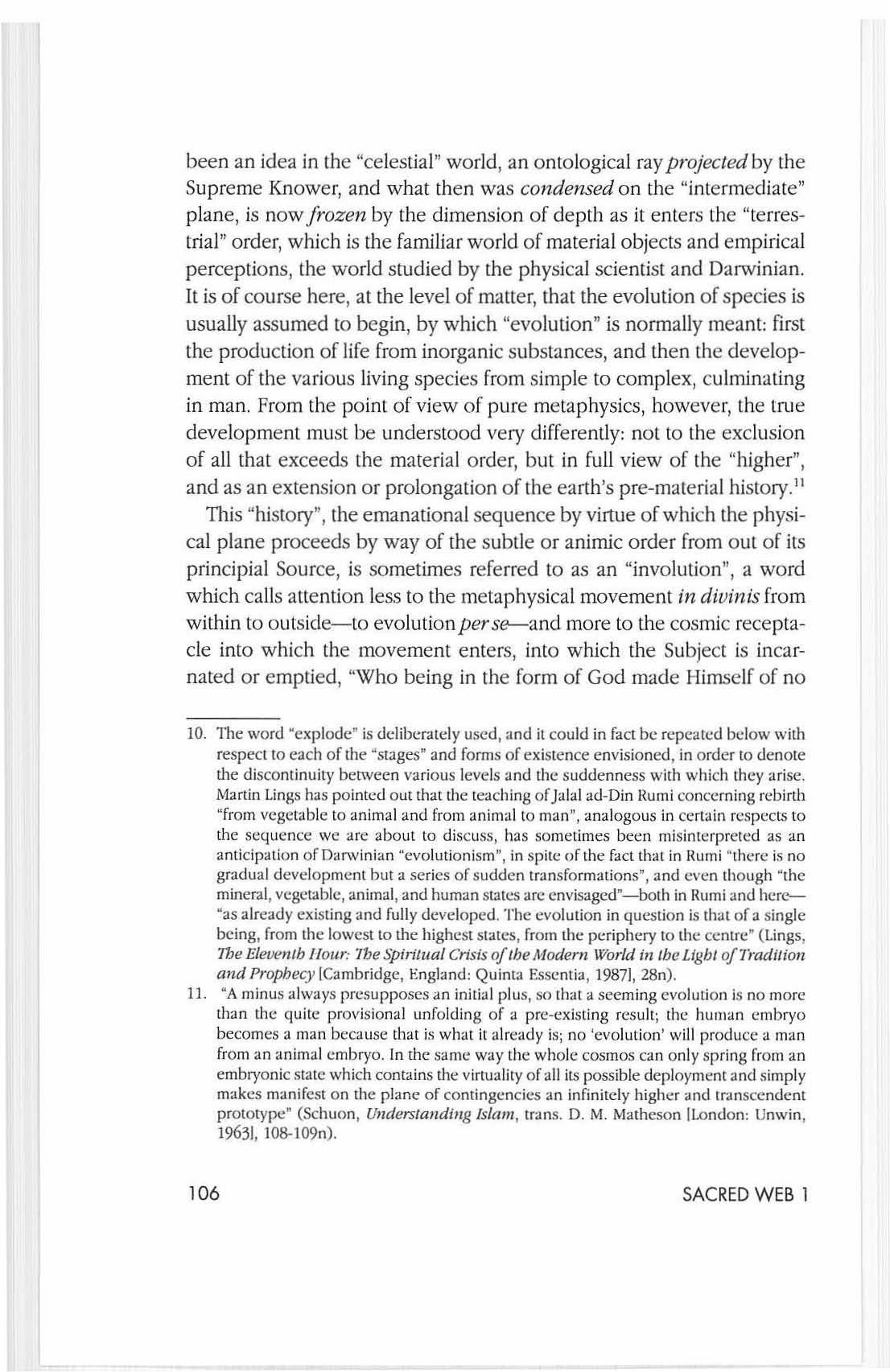
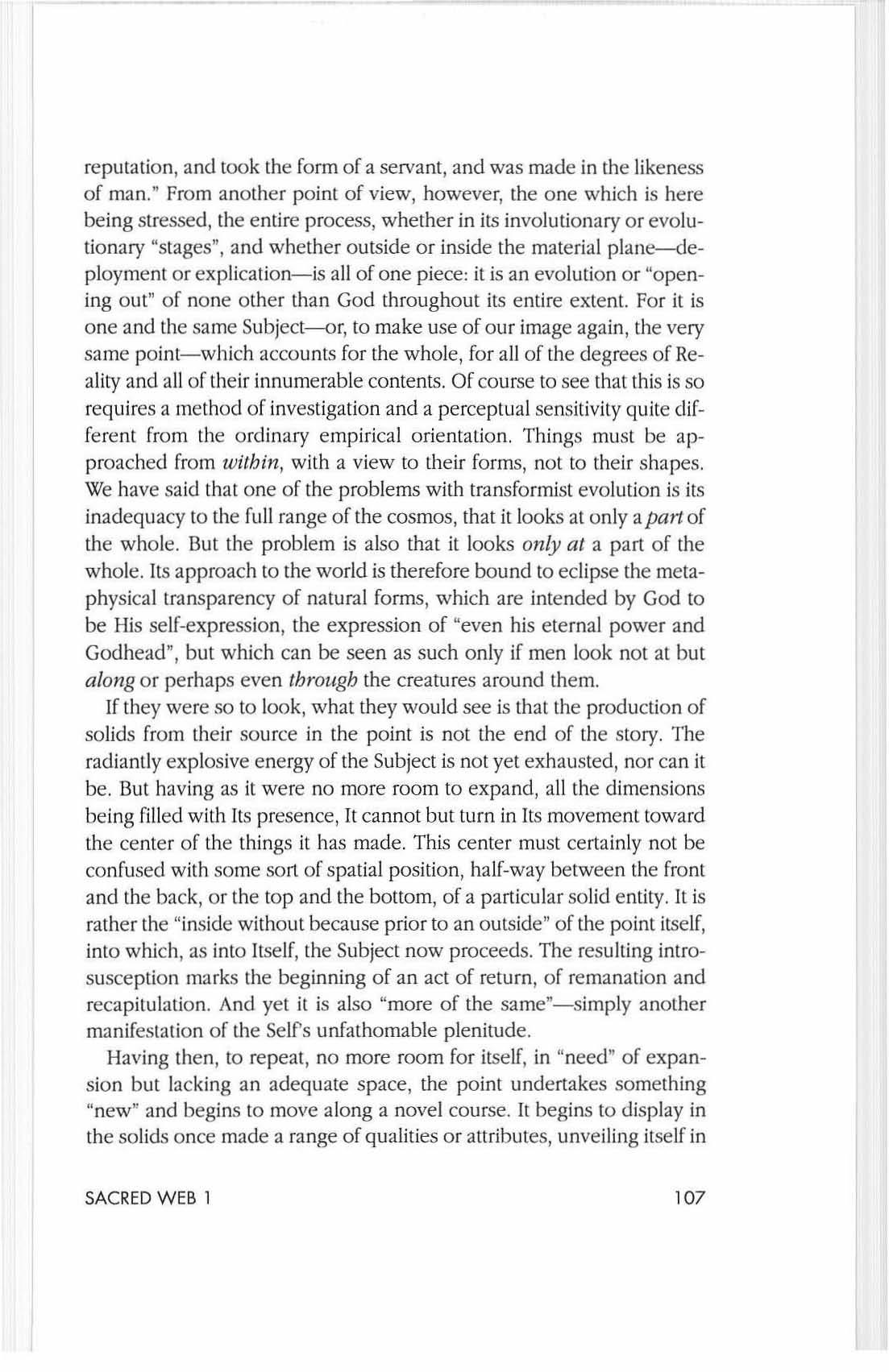
If they were so to look , what they would see is that the produ c tion of so lids fr o m th e ir source in the point is not the end of the s tory. The radiantly explosive energy of the Subject is not yet exhausted, nor ca n it be. But h avi n g as it were no more room to expand, all [h e dimen s ions being filled with Its presence, It cannot but turn in Its movement toward the center o f th e things it has made. This center mu s t certainly not be confused with some sort of spatial position, half-way betwe e n th e front and the back, or the top a nd th e bottom , o f a particular solid ent it y. It is rather the "in s ide without because prior to an outside" o f the po int itself, into which , as into Itself, th e Subj ect now proceeds . The result ing intros u scep ti o n marks the beginning of an act of return , of remanation and recapitulation . And ye t it is also "more of the sa me"-sim p ly another m a nifest ation of the SeWs unfathomable plenitude
Having th e n , to re peat , no more room fo r itself, in "ne ed" of expans ion but Ja c king an adequate space, the point undert akes something "new " and b e gins to move along a novel course. It begins to di s play in the solids once made a range of qualities or attribut es, unv e iling it se lf in th e how not the what, in th e kind n o t th e fact, of th e al ready ex isting material objects. Thus no sooner are the solids crysta llized than , by virtue of the same p re- material e m anat io nal ene rgy that first produ ce d th e m , there b egins to burgeon inside a se rie s of "high er dimensions." An int e riorizing action is initiated , according to which the manifestations of the Subj ec t become in cre asing ly ce nlral to the cre atures in qu es ti o n. At first th e point , having just co mpl e ted it s t hird and final "spatial " deployment, presents its elf in a uniform way throu gh o ut a p artic ula r ob ject, equally in lengt h, in breadth , and in d e pth , an d in the form o f a specia l property, as for exa mpl e in th e attra ct ive powe r o f the lodes tone or th e crys talline st ru ct ure of the diamond. Suc h a property is everywhere all th at it is, as much in th e p arts as in th e whole , a p iece o f a given substa nce having "as much " of th e qua li ty-to use the useless ness o f s uch language-as any ot h er. The Sou rce o f the s ub s tan ce, for those who h ave e ye s to see, is thu s writt en upon its very su rfac e .
But th e s urface of things is far too confining for the Subject. It ne eds t he a mplitud e afforded by Its ow n infinity , a n d soo n becomes "d iscontent n , diving b elow the surface o f p hys ica l objects , going "indoors", and the re presenting it se lf in the guise of a process. Here is th e beginning o f life in its organ iC ex pre ssio n and as unfolded o n th e insid e o f m atter. What one immed iately notices in look ing along suc h a process, howeve r-a lo ng a vit al or p h ysiologica l fun ction-i s that a certa in specialization among the pans o f th e whole has been introduced. Unlik e a mine r ai, not all of a li ving being is all that it i s all the way through Certa in aspec ts, even when th ey are not as clea rly di stin ct as th e indivi d ual organs o f the high er sp ec ies, assume a ce rtain pri o rit y as p rov idin g th e ch a nnels or openings through whic h life m ay ent er the e nli re being. T hese aspec ts are to the substance o f a li v ing crea tur e w hat the plane is to th e so lid ; th ey a re its condUio s ine qua non- in it , but no t of it Q uite the cont ra!)', it is depend e nt o n them. But mo re to th e pu rpose, where min e ral prop e rti es h ad been tou resl ri cl ive , th e more inward c ha racte r of biological process provides the Subject w ith add iti onal o ppo nun iti es for expans ion, as is evi d ent in growt h . Al thou gh the manifes tation of th e Subjec t in organi c life has b ecome in a se n se itse lf res tri cte d to certai n more o r less sp ecia li zed aspects of a n en tity , in a way that th e propert ies o f a diamond are n o t, th ese aspects are actua ll y ope n along a m e taphysical passageway to far wider possibilities th an inorg an ic m atter pe r se ca n allow for, and it is thu s th a t th e re e nter into th e being th e uun c reated e ne rgies" th at a re necessary for the unfo lding o f its life. It is in thi s se nse that the p lan l kingdom, th o ugh emerging later in Ihe temporal seque nce, may be said to be higher than the mineral , for the plant prov ides a g reate r d egree o f ope nn ess to its so ur ce. 12

Now we enco unt e r yet anothe r de velopment, a furth e r "evo lution " of t h e point. Althou g h the plant is able to grow and b lossom in a way Ih at th e min era l c annot, it rema in s s ubje ct to limitati o ns, which the Sub ject mu s t sti ll overco me, limitations viSib ly expressed in its attachment 10 the ea rth . If unrest ri cted e man a ti o n is to continu e, therefore , a n altogether diffe rent access mu s t be prov ided through which the p o int might be e nabl ed to p ass int o an e ve n more re s pl e nd e nt qu a litativ e exp ress ion. He re, it wou ld seem, is t he metap hysica l ex plan a ti on for th e birt h of sen ti e nce and the power of locomotion, the two most telling features of th e kingdom next to deve lo p , t h at of th e anima ls. An even mo re prono un ced inten'orization has he re taken place, for w hit e an an imal's movement is a lrea d y a sig n of deeper capa citi es ev ide nt eve n to a pu re ly empirical o utl ook, th e power of co nsc io us response w hi c h gives rise to t hi s movement , and w hi ch ca n be seen (o nce again) o nl y by "looking along" the locomo ti on, is eve n furth er within th an t he power of life, and ye t , precise ly because it is fu n her ins ide, it is correspo ndingl y close r to an exter io ri za ti o n or evo lu tion on the othe r side of the creatu re, t he s id e opposed to the fa ce t discerned by the p ure ly sensory eye-even as form is on th e furth er, but sha p e on the hither, side o f mat eria l objects. As th e point strives to mak e room for itse lf in a s pace that is already ex h a usted, c hann e ls a re es t ab li s hed t h roug h w hi ch there can fl ow the g rea ter inte n s ity of se nti e n ce. It is in thi s way that the flower is o p ene d to the butte rfl y, a blossom re leased from its stem. 13 Neverthe less, thi s release o r lib eratio n co uld not have been accomplished by the plant on it s ow n
12. A qualificat io n to tbis principle is in order, however, si nce the "mctaphysical (Se lmon) of a given crca ture depends not o nly upon the plane of being it occu pies , but upo n its relative "centra lit yDon that plane-its proximity to the point at which that plane is intersected by the axis mUlldi-not to mention other imponderables. Wh il e pla nts may in gene ral be "high er" than minerals, becau se o f th e o rgan iC life that is in them , a precious gem rem:lins a more lucid theophany than a weed l11e same qualification mus t be applied (0 the rdative pos iti ons in the great c hain of being o r p lants and an imals, and of animals a nd man. A nob le animal, like an eagle or a li on, is "more Divine " than a h uman being who lives below himself. We do not in any case mean to propos e a rig id system.
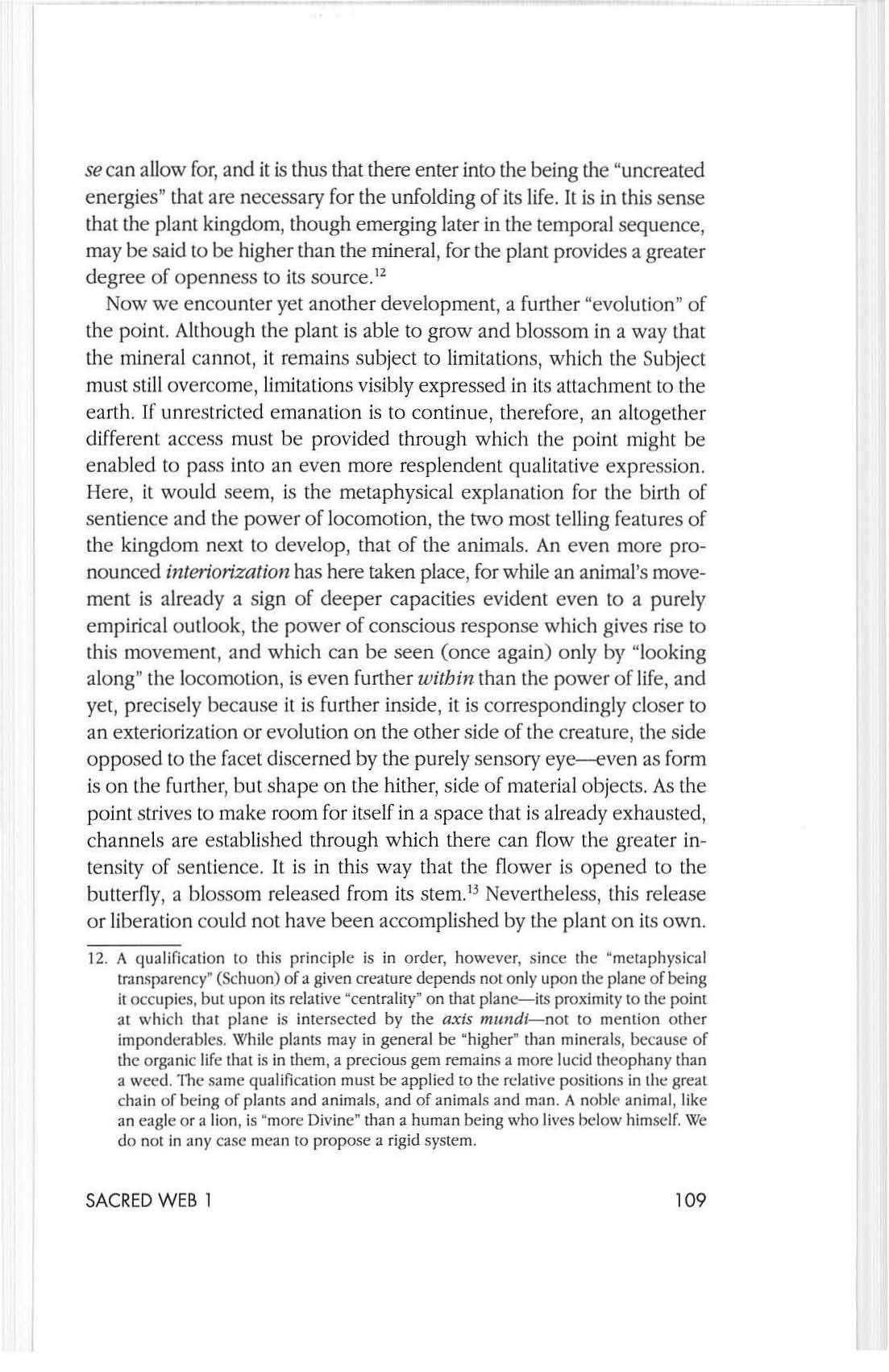
The flower ha s se rved as a portal for creative l causative Power, but is not itself that cause. Even as apart from th e plane the line wou ld remain invisible , in proportion as the plane apart from the solid wou ld be gible l so in the abse nce of life would consciousness be hidden from the organs of sense, On the other hand , the plane could not exist a t all apart from the lin e, nor the solid without the plane I nor any dimen s ion were it not for th e point ; and were it not for the Subjec t, neither matler, nor life , nor sentience would ever have been deployed o r explicated-Subject through matter as life, and Subject thr o ugh life as se nti e n ce.
It is worth pausing to emphasize the radical differenc e belween this view of the seq uence of form s and that of the DaIWinian or transformist theory. The metaphysician is not saying that matter evolves into life , or life into sentience. NorIan a smaller sca le, do amphibians evolve into reptiles I or reptiles into birds ; Ga lapagos finches are always fin ches, and peppered moth s are always m o ths. 14 The on ly evolution is that of the point , which is the Divine Self as Subject. The fo rms of existence through which It "pa sses", in a stric tly non -temporal and instantan eous way I do not th emse lve s change, for th ey are th e unalterable imag es of celestial ideas-the dist inct and immutable s h adows cas t by the Divine Slin as It shines up on t he e te rnal archetypes of Its myriad crealures. 15
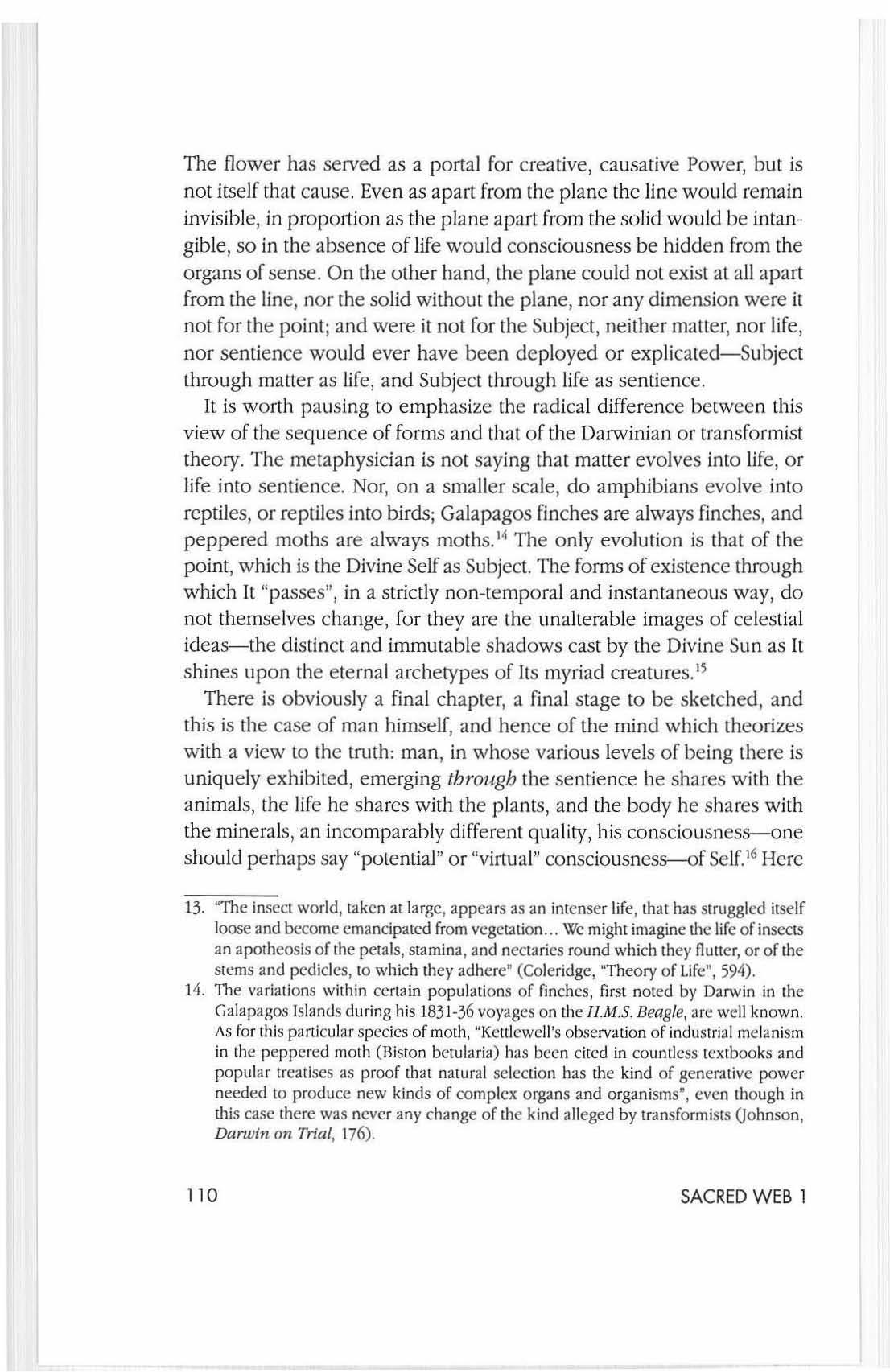
There is obvious ly a final ch a pter, a final s tage to be sketched, and thi s is th e case of man himself, and hence of the mind which theorizes w ith a v iew to t he truth : man , in whose various levels o f being th e re is uniquely exhibite d l emerging throllgh the senlience he shar es with the animals, the life he s hares with the plants l and the body h e s hares with the rninerai s l an incomparably different quality, his consciousness-one s hould perhaps say "potential l ' or "v irtual" consciousness-of Se lf. 16 Here the in tropulsive, and inte riorizing tendency of th e point ha s "a t la st " caugh t up to having step by step provided ever more e xt e nded poss ibil itie s for irradiation , "unt il" th e leve l is reached where it "beco mes " the field o f its very own moti o n and expression. The circl e ha s bee n closed ; the goa l is attained . Intellection h as ful fill ed its reason for be ing and has re aliz ed in the only fully adeq uate way th e pl e nitud e of its unco nditioned freedom, within th e limi tl ess "space " of its very Se lf. Fo r to say man, the last o f th e s pecies to appear o n th e is to say capa c ity for the Abso lut e and the In fi nite , for th e Supreme Reality, s ince it is o nly in man , of a ll c reatur es, t h at the Su bj ec t is able to find a sufficie nt accom mo dati on fo r Its full inte ns ity . No me re bodil y, three dim e ns io nal e ntity as suc h ca n ho pe to co ntain the fans et origo of a ll nor do the udime ns ion al" qualities , wh e ther property (as a lion o f the so lid ), life (as a recap itul ation of th e plane), or se nt ience (as a recapitulation o f th e lin e) eve r more than approac h It. Its ene rgy is suc h th a t It ca n be fully manifest only in a mode which is equ ally infinite an d t herefore equa ll y w ithout dim e nsion-equa lly lik e a point. But th is is precisely what Se lf-co nsciou s ness is, what int e llec ti o n and noesis ar e : an unbounded insta ntaneou s inwardness , which, like th e att ri butes of life a nd is nOl at all of th e hum an body, but which unlike th ese lowe r qualiti es is not eve n in it , because n ot exp ressed eve n as it
13. "The insect world, taken at large , appears as an intenser life, that has sl'tU ggJc d itsel f loose and tx.>come ema ncipated from vege tati on We might imagine the life of insects a n apotheosis o f th e petals, s ta mina , and nec taries round which th ey flutter, or of the ste ms and pcdiclcs, to which they adhere " (Co le rid ge, ·'nlcory of Life ", 594).
14, TIle variati ons within certain p o pulati ons of fin c he s, first noted by Darwin in Ihe Galapagos Island s during his 1831 -36 vO}"Jges on the HM.5 Beagle, arc we ll known. As for this part ic ular species of moth, "Ke ttlew e ll 's obse rvation of indu strial melanism in Ihe p eppered moth (Biston betularia ) ha s been cited in countless textbooks and popular treatises as proof that natural se lec ti o n ha s {he kind o f generative power need e d 10 produce new kinds o f co mpl ex o rgan s and organisms ·, even though in this case th ere was never any change o f the kind a ll ege d b y tr,lIlsformiSls (Jo hn son, Danviu 011 Trial , 176).
15 is the unfO ld ing of a given virtuality and not the passage of a give n possibi li ty to a qu ite differen t possib ilit yn (Schuon , unpublished leiter to the author). "The form o f a peripheral b ei ng , wh et h e r it be an im al, vegetab le, o r min er al , reveals ;tllthatlhe being kn ows, a nd is as it were itself identified with thi s knowledge; it can be said, therefor e, that the form o f s uch a being gives a true indicati on of its contemp lative s tate or dream Nee dle ss to say , the object of knowledge or o f intelligence is always and by defini tion the Divine Prin c ipl e and cannot be anything else , s ince It is metaphy s ically th e only Reality; b ut thi s o bjec t o r content can vary in form in confo rmity with the indefinite diver s it y of the modes and degree s o f Intellig e nce renected in crea tures " (Schuon , tbe Trall sce ,u Jen l lhlity of Religi o lls [Wheaton , Illinois: T h e l11 eos ophical P ubl ishing Ho us e, 19841 , 56) .
16. Not ice the emphasis on the prepos iti on lh rollgb , n ot "from ", Man 's consciousness of himself, hi s p ower of self- refl ec ti on, ca n obviously comc o nl y from the Self, on p ain o f the co ntradicti o n referred to ea rli e r in considering th e sixt h of the Darwinian e rrors. Fa ilure to attend to thi s crucial "prepos iti o nal " diffe rence can result in a kind of "o pti cal illusion" , whi ch is pe rhaps at the root o f that impossible co mprom ise popularly known as evolutionism " , whose proponents contend that God some how manages to crea te the wo rld by means of the process described by Darwi n . It s h oul d be clear by now that th e mel aphysfca/or eman aliolla f gcvolution M here envisioned ha s nOthing in com mo n with th is ab s u rdity were on its "edge", as the p lane and th e lin e ca n be seen o n th e s id es and th e corne rs of soli ds. "Word as He was, so far from be ing co nt aine d by anything, He ra ther contained all thing s Himself' (St Alh a na s ius).17 The act of onlOlogica l knowing iss ues from a ce ntral a nd hidden point so concentrated as to exceed altoget h er th e reach of the body and, hence, the all too limited means of empirical resea rc h . Although as t hi s sketc h has been intended to s how man 's int e lligence can be sa id to evolve through what is beneat h it in th e o rd er of being, it evolves even so, and can only evo lve, Jrom th e hi g her and indeed as the Hi ghest. What is length, bread th , and then d e pth o n th e way "down" to th e eart h b ecomes triply and in ve rsely di sp layed o n its way "in ", and in a ce rtain sense "up", as th e qualities of physica l subs tance-in property , process, and sentie n ce-the premateria l co ns tru c ti o n of matter being mirrored in the s u ccess ion of crea lUres. And yet none of the dimensio ns wo uld be w ha t it is, nor wo uld th e dimensional quali ties be recognized for what they a re , if it were not fo r the point, the sovere ign Subjec t, w hich is b o th beginning and end."
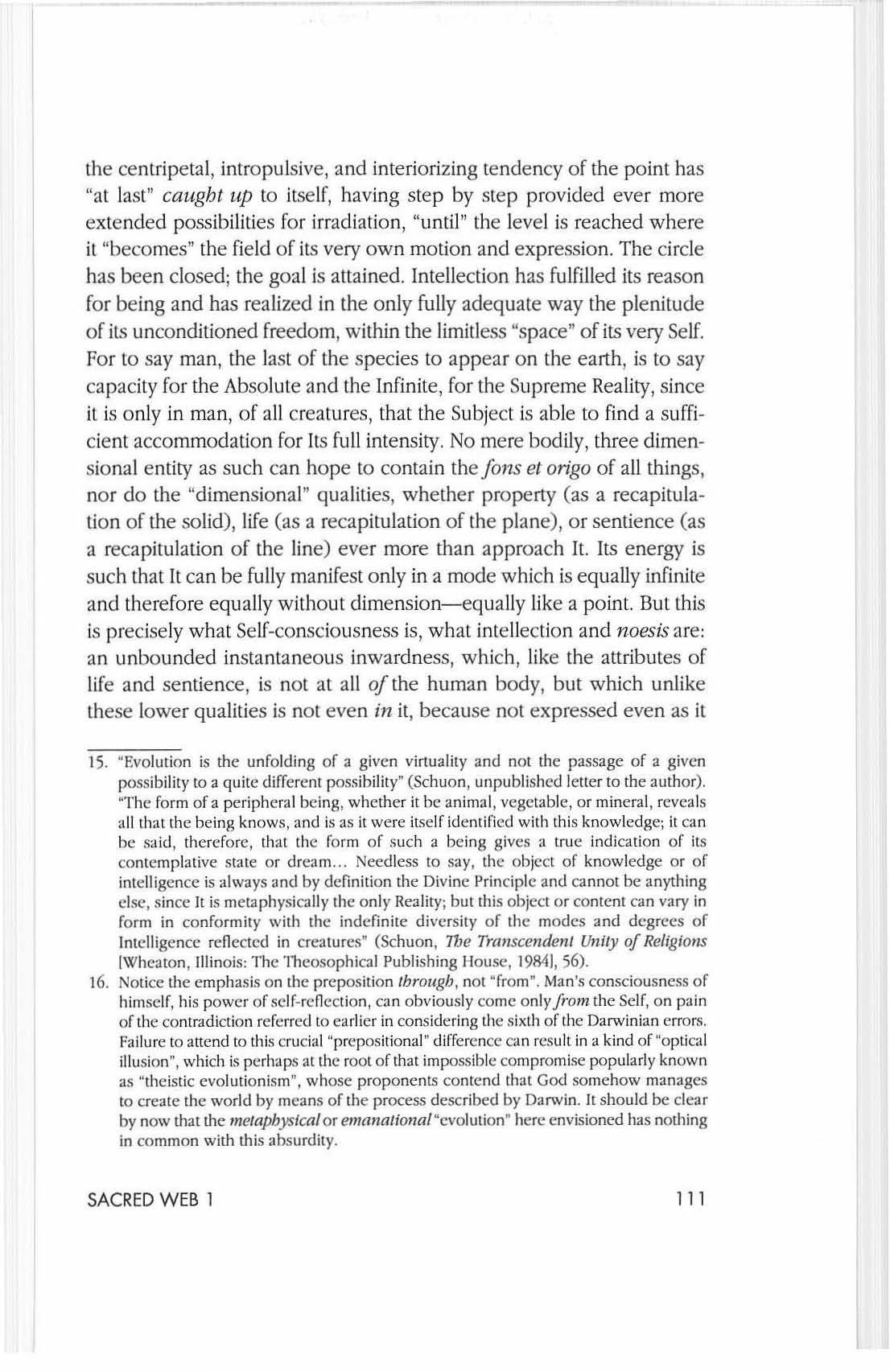
As announced at the outset, the aim of thi s art icl e has been to provide an acco unt of the worl d per ascensum whic h is in full conformity w it h the v iew per "escens"", propounded by metaphysics and th eology ; a nd we have th erefore been obliged to insist throughout that none "hath cended up to Heaven, but He that came down from Heaven, even the Son of Man which is in Heave n "-hence that no infrap erso n al o r evo lut ionaIY exp lanation of the world ca n have th e s li g ht est va lu e unless it acknowledges, and repeated ly stresses, the absolu te supre macy of God, our ultimate Source. 19 Nonet he less we have also assumed that the sequ e nce in the terrestria l appearance of certa in forms of ex istence is not without a symbolic message , and that reading that message in the li g ht provided by traditional authorities might he lp to point certain of our contemporaries, who w ish to make so much o f the "facts" and who often false ly su ppose them to be incompatib le with a Divine explanation, back and up to princip les. For truths are always consistent with Truth.

17. 'ne saint adds tbat "man , enclosed on every side by the works of c re ation and everywhere beh o lding the utlfo/ded Co dhe(ld of the Word, is no longer de ceived concerning God - (our ita lics).
18. · When all is sa id and done , there are o n ly thre e miracles: existence , life, int elligence; with intelligen ce , the c urve springing from God closes on itself, like a ring which in reality ha s never Ix'en parted from the Infinite " (Selmon , light OIl/he Anclellt lVorlck , 42). "As re gard s manife station , i1 may be said that the 'Self' develop s lis manifold possibilitie s , indefinite in their multiwde , through a multiplicity o f modalities of realization, amounti ng , for the int egral being"-represented here by the point- "to so many differe nt states , of which state s one alone , limited by the spc c i:ll conditions of existenc e whi c h define it , l: o n s titutes the portion or r:llher (hI.! particular determinati o n of that being which is c alled human indiVid uality · (R e ne Guenon , Mall and llis Becomillg Acco rdillg/o Ihe Vedanta , tran s Richard C. Nich olson INc w York : 111 C Noo nda y Press, 19581, 29-30).
Whateve r th e b ene fit s of this reading, and quite a part from th e question of whether it might prov e as convincing to the theologian as to the metaphysician, it is wo rth emp h asizing once again that the picture prese nte d here is preci se ly a "pict ure "-no more th an a ske tch, a possible darsbana. Simply because a certai n vocabula.ry and p articu lar images hav e b ee n used as mai e utic means , no one s hould imag ine that all others have been th ereby exclu d ed. We read ily admit that thi s cosmogony do es not, can no t, and n eed not sta nd opposed to ot her equally effective "impersonal" visions, provided of co urse that they a re equally subjec t to
19. 'l1lOUgh far less ha s been said of a spccifkally nature or in dogmatic terms, and far more along metaphysical lines, the theological bases for an acceptable interpretation of evolution should be deducible from this and other tmuitional Christian teachings a llu ded to at vario us points throughout this :lrtide. Further support can be found in the dogma of the early Church regarding th e Blessed Virgin as the 71Jeotokos o r "Mothe r of and in th e metaphysical insigh t it affords concerning the substance of materia prima, a sub stan ce which is not unconnected (when rightly considered) to that "material maner" through which the "message sent by God from Himself passes on its way of return. Even as that Man was born of Mary in Whom was "recapit ulated the ancient making of Adam n (St lrena eus)-t hat is, the e terna l emanation of primordial man in dlvinfs-the Virgin being the earth ly expression of the "fecundation latent in eternity" (Eckhart): so there proceed out of matter, and by virtue of th e "dimensional n elaborations described above , the forms of the minerals, p lants, and anima ls , which we re Hk(."wise "already· etern:llly made, and tbrougb the material coagu lations " of which the idea of Man is enab led to move in its tow. m ls full d isclosure on earth, As 5t Anselm writes , "11, e Iioly Ghost and 'the powe r of the Mos t High ' wonderfully begal a Man from a Virgin MOthe r. Thus with respect to the others it tay in Adam, that is, in his power, that they should have being from him, but with respect to this Man it did not lie in Adam that lie should exist in any way, any more than it lay in the slime tbat the first m:ln, who was made from it, shou ld corne from it in a wonderful way, or in th e man, thai Eve should be of him, as in facl she was made. But it did not lie in any o f them, in whom! Ie was from Adam to Mary , that He should exist. Konetheless, He was in them , because that from which I Ie was to be laken was in them, just as Ihat from which the fi rst man was made was in the slime , and that from which Eve was made in him. He was in them, however, not by the creature 's will or strength, but by the Divine Power the irrefragable truths of pure metaphysics, co ncerning w hi ch there can be no compromise. It is to be understood in a ny case tha t the suffic ient rea son for havi ng a view of the cosmos is not that it might correspond in some more or less mathematical way to the world as it is in itse lf, which is as far beyond perfect comprehens ion as it is below perfect being. The aim instead is to provide va riou s keys or supports for intellection, that uncreated power of knowing What is and being What knows by w hich we are enabled to trJnscen d this world altoget her-t hough then only in seei n g, through a prayerful loo kin g along it , tha t th is same world is "a lready" the kingdom of God Adveniat ,'egnum tuum , fiat vo/unlas lua, sicut in caelo el in terra.
